Beyond Color Boundaries: Pioneering Developments in Cholesteric Liquid Crystal Photonic Actuators
Abstract
:1. Introduction
2. Basic Concepts
2.1. Cholesteric Liquid Crystals
2.2. CLC Structural Color Elastomers
- (a)
- CLC structural color elastomers
- (b)
- CLC structural color fibers
- (c)
- Advantages of CLC structural color elastomers
2.3. CLC Structural Color Actuators
3. Dynamically Adjustable Cholesteric Liquid Crystal Structural Color Actuators
3.1. Mechanical Response CLC Photonic Actuators (CLCPAs)
3.2. Thermal Response CLC Photonic Actuators
3.3. Electrical Response CLC Photonic Actuators

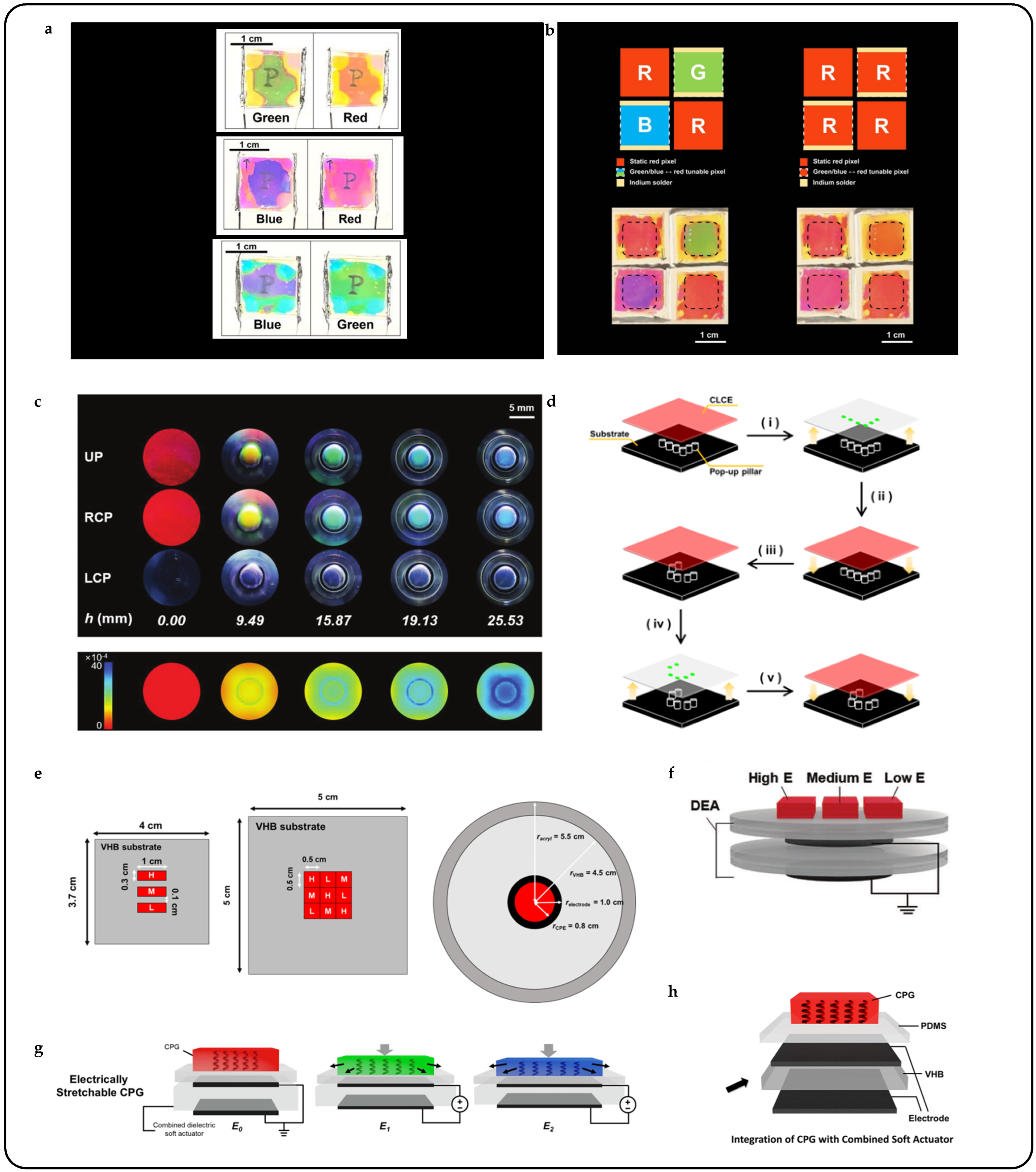
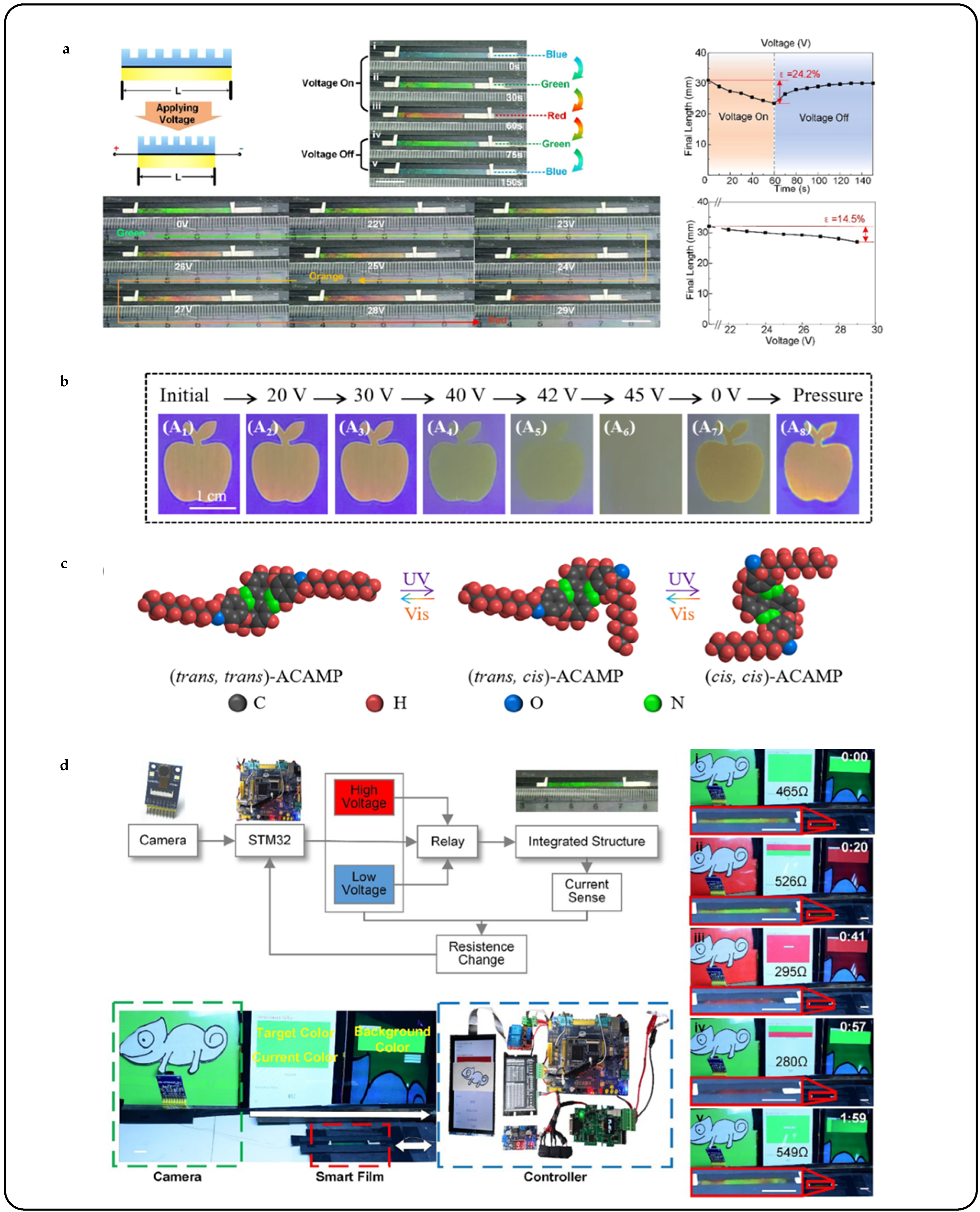
3.4. Light Response CLC Photonic Actuators
3.5. Humidity/Magnetic/Pneumatic Response CLC Photonic Actuators
4. Advanced Optical Applications
4.1. Colorimetric Sensing
4.2. Smart Wearable Fabrics and Devices
4.3. Advanced Color Filter
4.4. Novel 3D Printing
4.5. Optical Cloaking and Camouflage
5. Conclusions and Outlook
Author Contributions
Funding
Conflicts of Interest
References
- Viana, J.V.D.; Vieira, C.; Duarte, R.C.; Romero, G.Q. Predator responses to prey camouflage strategies: A meta-analysis. Proc. R. Soc. B-Biol. Sci. 2022, 289, 20220980. [Google Scholar] [CrossRef] [PubMed]
- How, M.J.; Santon, M. Cuttlefish camouflage: Blending in by matching background features. Curr. Biol. 2022, 32, R523–R525. [Google Scholar] [CrossRef] [PubMed]
- Wuthrich, K.L.; Nagel, A.; Swierk, L. Rapid Body Color Change Provides Lizards with Facultative Crypsis in the Eyes of Their Avian Predators. Am. Nat. 2022, 199, 277–290. [Google Scholar] [CrossRef] [PubMed]
- Teyssier, J.; Saenko, S.V.; van der Marel, D.; Milinkovitch, M.C. Photonic crystals cause active colour change in chameleons. Nat. Commun. 2015, 6, 6368. [Google Scholar] [CrossRef] [PubMed]
- Saenko, S.V.; Teyssier, J.; van der Marel, D.; Milinkovitch, M.C. Precise colocalization of interacting structural and pigmentary elements generates extensive color pattern variation in Phelsuma lizards. BMC Biol. 2013, 11, 1–13. [Google Scholar] [CrossRef] [PubMed]
- Williams, T.L.; Senft, S.L.; Yeo, J.J.; Martín-Martínez, F.J.; Kuzirian, A.M.; Martin, C.A.; DiBona, C.W.; Chen, C.T.; Dinneen, S.R.; Nguyen, H.T.; et al. Dynamic pigmentary and structural coloration within cephalopod chromatophore organs. Nat. Commun. 2019, 10, 1004. [Google Scholar] [CrossRef] [PubMed]
- Sköld, H.N.; Aspengren, S.; Wallin, M. Rapid color change in fish and amphibians—Function, regulation, and emerging applications. Pigm. Cell Melanoma Res. 2013, 26, 29–38. [Google Scholar] [CrossRef] [PubMed]
- Goda, M. Rapid integumental color changes due to novel iridophores in the chameleon sand tilefish Hoplolatilus chlupatyi. Pigm. Cell Melanoma Res. 2017, 30, 368–371. [Google Scholar] [CrossRef] [PubMed]
- Mitov, M. Cholesteric liquid crystals in living matter. Soft Matter 2017, 13, 4176–4209. [Google Scholar] [CrossRef]
- Zhang, W.; Schenning, A.P.H.J.; Kragt, A.J.J.; Zhou, G.; de Haan, L.T. Reversible Thermochromic Photonic Coatings with a Protective Topcoat. ACS Appl. Mater. Interfaces 2021, 13, 3153–3160. [Google Scholar] [CrossRef]
- Geng, Y.; Kizhakidathazhath, R.; Lagerwall, J.P.F. Robust cholesteric liquid crystal elastomer fibres for mechanochromic textiles. Nat. Mater. 2022, 21, 1441–1447. [Google Scholar] [CrossRef] [PubMed]
- Choi, S.S.; Wang, D.; Nam, S.; Jung, W. Electrically reconfigurable optical color filters using heterogeneous chiral liquid crystals. Res. Sq. 2022. [Google Scholar] [CrossRef]
- Bobrovsky, A.; Shibaev, V.; Cigl, M.; Hamplová, V.; Bubnov, A. Fast photo- and electro-optical switching of the polymer- stabilised cholesteric liquid crystal composite prepared by the template method. Liq. Cryst. 2023, 50, 1563–1572. [Google Scholar] [CrossRef]
- Zhang, Z.H.; Yang, X.Y.; Zhao, Y.J.; Ye, F.F.; Shang, L.R. Liquid Crystal Materials for Biomedical Applications. Adv. Mater. 2023, 35, 2300220. [Google Scholar] [CrossRef] [PubMed]
- Hussain, S.; Zourob, M. Solid-State Cholesteric Liquid Crystals as an Emerging Platform for the Development of Optical Photonic Sensors. Small 2024, 20, 2304590. [Google Scholar] [CrossRef] [PubMed]
- Huang, C.T.; Chiu, C.J.; Liu, C.K.; Cheng, K.T. Method for examining the structural information of heliconical structures of chiral nematics via analyses of the observations of colors and gray levels. Opt. Laser Technol. 2024, 169, 109897. [Google Scholar] [CrossRef]
- Xiang, J.; Shiyanovskii, S.V.; Imrie, C.T.; Lavrentovich, O.D. Electrooptic Response of Chiral Nematic Liquid Crystals with Oblique Helicoidal Director. Phys. Rev. Lett. 2014, 112, 217801. [Google Scholar] [CrossRef]
- Bragg, W.H. The reflection of X-rays by crystals. Nature 1913, 91, 477. [Google Scholar] [CrossRef]
- Bragg, W.L.; Thomson, J.J. The diffraction of short electromagnetic waves by a crystal. Proc. Camb. Philos. Soc. 1914, 17, 43–57. [Google Scholar]
- Dreher, R.; Meier, G. Optical Properties of Cholesteric Liquid-Crystals. Phys. Rev. A 1973, 8, 1616–1623. [Google Scholar] [CrossRef]
- Belyakov, V.A.; Dmitrienko, V.E.; Orlov, V.P. Optics of Cholesteric Liquid-Crystals. Uspekhi Fiz. Nauk. 1979, 127, 221–261. [Google Scholar] [CrossRef]
- Zhou, H.M.; Wang, H.; He, W.L.; Yang, Z.; Cao, H.; Wang, D.; Li, Y.Z. Research Progress of Cholesteric Liquid Crystals with Broadband Reflection. Molecules 2022, 27, 4427. [Google Scholar] [CrossRef] [PubMed]
- Ma, L.L.; Li, C.Y.; Pan, J.T.; Ji, Y.E.; Jiang, C.; Zheng, R.; Wang, Z.Y.; Wang, Y.; Li, B.X.; Lu, Y.Q. Self-assembled liquid crystal architectures for soft matter photonics. Light-Sci. Appl. 2022, 11, 270. [Google Scholar] [CrossRef] [PubMed]
- Mitov, M. Cholesteric liquid crystals with a broad light reflection band. Adv. Mater. 2012, 24, 6260–6276. [Google Scholar] [CrossRef] [PubMed]
- Mitov, M.; Dessaud, N. Going beyond the reflectance limit of cholesteric liquid crystals. Nat. Mater. 2006, 5, 361–364. [Google Scholar] [CrossRef] [PubMed]
- Sano, H.; Ishii, A.; Mizuno, T.; Takasago, R.; Kato, S.; Ishiguro, M.; Hayata, Y.; Nagai, M.; Ito, Y. Novel cholesteric liquid crystal films creating angle insensitive reflective colors. J. Soc. Inf. Disp. 2023, 31, 373–379. [Google Scholar] [CrossRef]
- Choy, C.L.; Lau, K.W.E.; Wong, Y.W.; Yee, A.F. Elastic moduli of a liquid crystalline polymer and its in-situ composites. Polym. Eng. Sci. 1996, 36, 1256–1265. [Google Scholar] [CrossRef]
- Amela-Cortes, M.; Bruce, D.W.; Evans, K.E.; Smith, C.W. Unsymmetric main-chain liquid crystal elastomers with tunable phase behaviour: Elastic response. J. Mater. Chem. 2011, 21, 8436–8442. [Google Scholar] [CrossRef]
- Geng, Y.; Lagerwall, J.P.F. Multiresponsive Cylindrically Symmetric Cholesteric Liquid Crystal Elastomer Fibers Templated by Tubular Confinement. Adv. Sci. 2023, 10, 2301414. [Google Scholar] [CrossRef] [PubMed]
- Wang, Y.C.; Liu, J.Q.; Yang, S. Multi-functional liquid crystal elastomer composites. Appl. Phys. Rev. 2022, 9, 011301. [Google Scholar] [CrossRef]
- Park, M.S.; Kim, K.; Lee, Y.J.; Na, J.H.; Kim, S.U. Deformable Photonic Crystals Based on Chiral Liquid Crystals with Thermal-Mediative Shape Memory Effect. Materials 2023, 16, 35. [Google Scholar] [CrossRef] [PubMed]
- Shen, W.B.; Liu, J.S.; Du, B.; Zhuo, H.T.; Chen, S.J. Thermal- and light-responsive programmable shape-memory behavior of liquid crystalline polyurethanes with pendant photosensitive groups. J. Mater. Chem. A 2021, 9, 15087–15094. [Google Scholar] [CrossRef]
- Das, G.; Park, S.Y. Liquid crystalline elastomer actuators with dynamic covalent bonding: Synthesis, alignment, reprogrammability, and self-healing. Curr. Opin. Solid. State Mater. Sci. 2023, 27, 101076. [Google Scholar] [CrossRef]
- Yang, X.T.; Zhong, X.; Zhang, J.L.; Gu, J.W. Intrinsic high thermal conductive liquid crystal epoxy film simultaneously combining with excellent intrinsic self-healing performance. J. Mater. Sci. Technol. 2021, 68, 209–215. [Google Scholar] [CrossRef]
- Wang, Y.K.; Ma, Z.H.; Li, Z.G.; Zhang, Y.J.; Zhang, H.; Zheng, G.L.; Xiao, Y. Research on a novel temperature indicating device based on Bragg reflection waveguide of planar texture cholesteric liquid crystal layer. Mol. Cryst. Liq. Cryst. 2022, 739, 78–87. [Google Scholar] [CrossRef]
- Kim, Y.; Mafy, N.N.; Maisonneuve, S.; Lin, C.Q.; Tamaoki, N.; Xie, J. Glycomacrocycle-Based Azobenzene Derivatives as Chiral Dopants for Photoresponsive Cholesteric Liquid Crystals. ACS Appl. Mater. Interfaces 2020, 12, 52146–52155. [Google Scholar] [CrossRef] [PubMed]
- Kocakulah, G.; Koysal, O.; Kahyaoglu, A. Electro-optical Performance Investigation of Cholesteric Liquid Crystal Containing Azo Dye: Light Shutter Device Application. J. Electron. Mater. 2021, 50, 497–510. [Google Scholar] [CrossRef]
- Lan, R.C.; Shen, W.B.; Yao, W.H.; Chen, J.Y.; Chen, X.Y.; Yang, H. Bioinspired humidity-responsive liquid crystalline materials: From adaptive soft actuators to visualized sensors and detectors. Mater. Horiz. 2023, 10, 2824–2844. [Google Scholar] [CrossRef] [PubMed]
- Feng, W.; Pal, A.; Wang, T.L.; Ren, Z.Y.; Yan, Y.B.; Lu, Y.Q.; Yang, H.; Sitti, M. Cholesteric Liquid Crystal Polymeric Coatings for Colorful Artificial Muscles and Motile Humidity Sensor Skin Integrated with Magnetic Composites. Adv. Funct. Mater. 2023, 33, 2300731. [Google Scholar] [CrossRef] [PubMed]
- Wang, J.W.; Cai, W.F.; He, H.L.; Cen, M.J.; Liu, J.X.; Kong, D.L.; Luo, D.; Lu, Y.Q.; Liu, Y.J. Cholesteric liquid crystal-enabled electrically programmable metasurfaces for simultaneous near- and far-field displays. Nanoscale 2022, 14, 17921–17928. [Google Scholar] [CrossRef] [PubMed]
- Xiong, J.H.; Tan, G.J.; Zhan, T.; Wu, S.T. A scanning waveguide AR display with 100° FOV. In Proceedings of the Conference on Optical Architectures for Displays and Sensing in Augmented, Virtual, and Mixed Reality (AR, VR, MR) II, Electr Network, Virtual, 28–31 March 2021. [Google Scholar]
- Yang, C.J.; Wu, B.H.; Ruan, J.; Zhao, P.; Chen, L.; Chen, D.; Ye, F.F. 3D-Printed Biomimetic Systems with Synergetic Color and Shape Responses Based on Oblate Cholesteric Liquid Crystal Droplets. Adv. Mater. 2021, 33, 2006361. [Google Scholar] [CrossRef] [PubMed]
- Martinez, A.M.; McBride, M.K.; White, T.J.; Bowman, C.N. Reconfigurable and Spatially Programmable Chameleon Skin-Like Material Utilizing Light Responsive Covalent Adaptable Cholesteric Liquid Crystal Elastomers. Adv. Funct. Mater. 2020, 30, 2003150. [Google Scholar] [CrossRef]
- Xu, Z.; Liu, M.; Liu, Y.; Pan, Y.; Yang, L.L.; Ge, D.T. Mechano-Optical Response Behavior of Polymer-Dispersed Cholesteric Liquid Crystals for Reversible and Highly Sensitive Force Recorders. ACS Appl. Mater. Interfaces 2023, 15, 3673–3679. [Google Scholar] [CrossRef] [PubMed]
- Jiang, Q.; Zhao, D.X.; Wang, J.; Yan, H.C.; Cao, S.; Qiu, Y.; Wang, H.; Liao, Y.G.; Xie, X.L. Light regulation and long-lived stability of RGB colors in cholesteric liquid crystal physical gels via a mixing strategy. Soft Matter 2021, 17, 3216–3221. [Google Scholar] [CrossRef] [PubMed]
- Balenko, N.V.; Shibaev, V.P.; Bobrovsky, A.Y. Mechano-Optical Response of Novel Polymer Composites Based on Elastic Polyurethane Matrix Filled with Low-Molar-Mass Cholesteric Droplets. Macromol. Mater. Eng. 2021, 306, 2100262. [Google Scholar] [CrossRef]
- Yin, S.W.; Ge, S.M.; Li, X.S.; Zhao, Y.L.; Ma, H.M.; Sun, Y.B. Recyclable Cholesteric Phase Liquid Crystal Device for Detecting Storage Temperature Failure. ACS Appl. Mater. Interfaces 2023, 15, 35302–35310. [Google Scholar] [CrossRef] [PubMed]
- Skutnik, R.A.; Eichler, J.C.; Mazza, M.G.; Schoen, M. The temperature dependence of the helical pitch in a cholesteric liquid crystal. Mol. Phys. 2021, 119, e1881638. [Google Scholar] [CrossRef]
- Froyen, A.A.F.; Debije, M.G.; Schenning, A. Polymer Dispersed Cholesteric Liquid Crystal Mixtures for Optical Time-Temperature Integrators. Adv. Opt. Mater. 2022, 10, 2201648. [Google Scholar] [CrossRef]
- Wang, K.N.; Hu, W.T.; He, W.L.; Yang, Z.; Cao, H.; Wang, D.; Li, Y.Z. Research Progress of Electrically Driven Multi-Stable Cholesteric Liquid Crystals. Materials 2024, 17, 136. [Google Scholar] [CrossRef] [PubMed]
- Lu, H.B.; Wang, Q.; Zhu, M.M.; Huang, P.; Xu, M.; Qiu, L.Z.; Zhu, J. Electrically controllable reflection bandwidth polymer-stabilized cholesteric liquid crystals with low operating voltage. Liq. Cryst. 2022, 49, 1314–1321. [Google Scholar] [CrossRef]
- Du, X.X.; Yang, F.; Liu, Y.J.; Gleeson, H.F.; Luo, D. Light-Driven Dynamic Hierarchical Architecture of Three-Dimensional Self-Assembled Cholesteric Liquid Crystal Droplets. Langmuir 2023, 39, 1611–1618. [Google Scholar] [CrossRef] [PubMed]
- Liu, X.J.; Qin, L.; Yu, Y.L. Light-Driven Handedness Inversion of Cholesteric Liquid Crystals. Prog. Chem. 2023, 35, 247–262. [Google Scholar] [CrossRef]
- Gevorgyan, A.H.; Golik, S.S. On the Magnetooptics of Cholesteric Liquid Crystals. Opt. Spectrosc. 2022, 130, 163–172. [Google Scholar] [CrossRef]
- Peng, Z.L.; Huang, J.X.; Guo, Z.G. Anisotropic Janus materials: From micro-/nanostructures to applications. Nanoscale 2021, 13, 18839–18864. [Google Scholar] [CrossRef] [PubMed]
- Nam, S.; Wang, D.; Lee, G.; Choi, S.S. Broadband wavelength tuning of electrically stretchable chiral photonic gel. Nanophotonics 2022, 11, 2139–2148. [Google Scholar] [CrossRef]
- Nam, S.; Wang, D.; Kwon, C.; Han, S.H.; Choi, S.S. Biomimetic Multicolor-Separating Photonic Skin using Electrically Stretchable Chiral Photonic Elastomers. Adv. Mater. 2023, 35, 2302456. [Google Scholar] [CrossRef] [PubMed]
- Kim, S.T.; Finkelmann, H. Cholesteric Liquid Single-Crystal Elastomers (LSCE) Obtained by the Anisotropic Deswelling Method. Macromol. Rapid Commun. 2001, 22, 429–433. [Google Scholar] [CrossRef]
- Cicuta, P.; Tajbakhsh, A.R.; Terentjev, E.M. Photonic gaps in cholesteric elastomers under deformation. Phys. Rev. E 2004, 70, 011703. [Google Scholar] [CrossRef] [PubMed]
- Kizhakidathazhath, R.; Geng, Y.; Jampani, V.S.R.; Charni, C.; Sharma, A.; Lagerwall, J.P.F. Facile Anisotropic Deswelling Method for Realizing Large-Area Cholesteric Liquid Crystal Elastomers with Uniform Structural Color and Broad-Range Mechanochromic Response. Adv. Funct. Mater. 2019, 30, 1909537. [Google Scholar] [CrossRef]
- Zheng, N.; Xu, Y.; Zhao, Q.; Xie, T. Dynamic Covalent Polymer Networks: A Molecular Platform for Designing Functions beyond Chemical Recycling and Self-Healing. Chem. Rev. 2021, 121, 1716–1745. [Google Scholar] [CrossRef] [PubMed]
- Pei, Z.Q.; Yang, Y.; Chen, Q.M.; Terentjev, E.M.; Wei, Y.; Ji, Y. Mouldable liquid-crystalline elastomer actuators with exchangeable covalent bonds. Nat. Mater. 2014, 13, 36–41. [Google Scholar] [CrossRef] [PubMed]
- Huang, S.; Shen, Y.K.; Bisoyi, H.K.; Tao, Y.; Liu, Z.C.; Wang, M.; Yang, H.; Li, Q. Covalent Adaptable Liquid Crystal Networks Enabled by Reversible Ring-Opening Cascades of Cyclic Disulfides. J. Am. Chem. Soc. 2021, 143, 12543–12551. [Google Scholar] [CrossRef] [PubMed]
- Chen, L.; Bisoyi, H.K.; Huang, Y.L.; Huang, S.; Wang, M.; Yang, H.; Li, Q. Healable and Rearrangeable Networks of Liquid Crystal Elastomers Enabled by Diselenide Bonds. Angew. Chem. Int. Ed. 2021, 60, 16394–16398. [Google Scholar] [CrossRef] [PubMed]
- Jiang, Z.C.; Xiao, Y.Y.; Yin, L.; Han, L.; Zhao, Y. “Self-Lockable” Liquid Crystalline Diels-Alder Dynamic Network Actuators with Room Temperature Programmability and Solution Reprocessability. Angew. Chem. Int. Ed. 2020, 59, 4925–4931. [Google Scholar] [CrossRef] [PubMed]
- McBride, M.K.; Martinez, A.M.; Cox, L.; Alim, M.; Childress, K.; Beiswinger, M.; Podgorski, M.; Worrell, B.T.; Killgore, J.; Bowman, C.N. A readily programmable, fully reversible shape-switching material. Sci. Adv. 2018, 4, eaat4634. [Google Scholar] [CrossRef] [PubMed]
- Changmai, B.; Vanlalveni, C.; Ingle, A.P.; Bhagat, R.; Rokhum, L. Widely used catalysts in biodiesel production: A review. RSC Adv. 2020, 10, 41625–41679. [Google Scholar] [CrossRef] [PubMed]
- Yang, Y.; Terentjev, E.M.; Zhang, Y.B.; Chen, Q.M.; Zhao, Y.; Wei, Y.; Ji, Y. Reprocessable Thermoset Soft Actuators. Angew. Chem. Int. Ed. 2019, 58, 17474–17479. [Google Scholar] [CrossRef] [PubMed]
- Wang, Z.J.; Tian, H.M.; He, Q.G.; Cai, S.Q. Reprogrammable, Reprocessible, and Self-Healable Liquid Crystal Elastomer with Exchangeable Disulfide Bonds. ACS Appl. Mater. Interfaces 2017, 9, 33119–33128. [Google Scholar] [CrossRef] [PubMed]
- Wang, Z.J.; He, Q.G.; Wang, Y.; Cai, S.Q. Programmable actuation of liquid crystal elastomers via “living’’ exchange reaction. Soft Matter 2019, 15, 2811–2816. [Google Scholar] [CrossRef] [PubMed]
- Ma, J.; Yang, Y.; Valenzuela, C.; Zhang, X.; Wang, L.; Feng, W. Mechanochromic, Shape-Programmable and Self-Healable Cholesteric Liquid Crystal Elastomers Enabled by Dynamic Covalent Boronic Ester Bonds. Angew. Chem. Int. Ed. 2022, 61, e202116219. [Google Scholar] [CrossRef] [PubMed]
- Lai, J.C.; Mei, J.F.; Jia, X.Y.; Li, C.H.; You, X.Z.; Bao, Z.A. A Stiff and Healable Polymer Based on Dynamic-Covalent Boroxine Bonds. Adv. Mater. 2016, 28, 8277–8282. [Google Scholar] [CrossRef] [PubMed]
- Chen, L.; Chu, D.; Cheng, Z.A.; Wang, M.; Huang, S. Designing seamless-welded liquid-crystalline soft actuators with a “glue-free” method by dynamic boroxines. Polymer 2020, 208, 122962. [Google Scholar] [CrossRef]
- Kuenstler, A.S.; Hayward, R.C. Light-induced shape morphing of thin films. Curr. Opin. Colloid Interface Sci. 2019, 40, 70–86. [Google Scholar] [CrossRef]
- Dong, L.Q.; Feng, Y.Y.; Wang, L.; Feng, W. Azobenzene-based solar thermal fuels: Design, properties, and applications. Chem. Soc. Rev. 2018, 47, 7339–7368. [Google Scholar] [CrossRef] [PubMed]
- van Galen, M.; Kaniraj, J.P.; Albada, B.; Sprakel, J. Single-Molecule Force Spectroscopy of a Tetraaryl Succinonitrile Mechanophore. J. Phys. Chem. C 2022, 126, 1215–1221. [Google Scholar] [CrossRef] [PubMed]
- Liu, Z.C.; Bisoyi, H.K.; Huang, Y.L.; Wang, M.; Yang, H.; Li, Q. Thermo- and Mechanochromic Camouflage and Self-Healing in Biomimetic Soft Actuators Based on Liquid Crystal Elastomers. Angew. Chem. Int. Ed. 2022, 61, e202115755. [Google Scholar] [CrossRef] [PubMed]
- Bapat, A.P.; Sumerlin, B.S.; Sutti, A. Bulk network polymers with dynamic B–O bonds: Healable and reprocessable materials. Mater. Horiz. 2020, 7, 694–714. [Google Scholar] [CrossRef]
- White, T.J.; Broer, D.J. Programmable and adaptive mechanics with liquid crystal polymer networks and elastomers. Nat. Mater. 2015, 14, 1087–1098. [Google Scholar] [CrossRef] [PubMed]
- Lu, L.; Chen, X.; Liu, W.; Li, H.; Li, Y.; Yang, Y. Facile fabrication of patternable and large-area elastic liquid crystal polymer films. Liq. Cryst. 2023, 50, 1025–1034. [Google Scholar] [CrossRef]
- Zhang, P.; Zhou, G.F.; de Haan, L.T.; Schenning, A. 4D Chiral Photonic Actuators with Switchable Hyper-Reflectivity. Adv. Funct. Mater. 2021, 31, 2007887. [Google Scholar] [CrossRef]
- Belmonte, A.; da Cunha, M.P.; Nickmans, K.; Schenning, A. Brush-Paintable, Temperature and Light Responsive Triple Shape-Memory Photonic Coatings Based on Micrometer-Sized Cholesteric Liquid Crystal Polymer Particles. Adv. Opt. Mater. 2020, 8, 2000054. [Google Scholar] [CrossRef]
- Kragt, A.J.J.; Broer, D.J.; Schenning, A.P.H.J. Easily Processable and Programmable Responsive Semi-Interpenetrating Liquid Crystalline Polymer Network Coatings with Changing Reflectivities and Surface Topographies. Adv. Funct. Mater. 2018, 28, 1704756. [Google Scholar] [CrossRef]
- Sun, D.; Zheng, L.; Xu, X.; Du, K.; An, Z.; Zhou, X.; Chen, L.; Zhu, J.; Chen, D. Multi-functional stimuli-responsive biomimetic flower assembled from CLCE and MOF-based pedals. Chin. Chem. Lett. 2023, 34, 107208. [Google Scholar] [CrossRef]
- Hatamie, A.; Angizi, S.; Kumar, S.; Pandey, C.M.; Simchi, A.; Willander, M.; Malhotra, B.D. Review—Textile Based Chemical and Physical Sensors for Healthcare Monitoring. J. Electrochem. Soc. 2020, 167, 037546. [Google Scholar] [CrossRef]
- Jung, M.; Jeon, S.; Bae, J. Scalable and facile synthesis of stretchable thermoelectric fabric for wearable self-powered temperature sensors. RSC Adv. 2018, 8, 39992–39999. [Google Scholar] [CrossRef] [PubMed]
- Liu, X.Y.; Lillehoj, P.B. Embroidered electrochemical sensors for biomolecular detection. Lab. Chip. 2016, 16, 2093–2098. [Google Scholar] [CrossRef]
- Li, B.T.; Xiao, G.; Liu, F.; Qiao, Y.; Li, C.M.; Lu, Z.S. A flexible humidity sensor based on silk fabrics for human respiration monitoring. J. Mater. Chem. C 2018, 6, 4549–4554. [Google Scholar] [CrossRef]
- Parrilla, M.; Cánovas, R.; Jeerapan, I.; Andrade, F.J.; Wang, J. A Textile-Based Stretchable Multi-Ion Potentiometric Sensor. Adv. Healthc. Mater. 2016, 5, 996–1001. [Google Scholar] [CrossRef] [PubMed]
- Kim, S.Y.; Jee, E.; Kim, J.S.; Kim, D.H. Conformable and ionic textiles using sheath-core carbon nanotube microyarns for highly sensitive and reliable pressure sensors. RSC Adv. 2017, 7, 23820–23826. [Google Scholar] [CrossRef]
- Foelen, Y.; van der Heijden, D.A.C.; Verdurmen, A.M.J.; Mulder, D.J.; Lub, J.; Schenning, A. Thermal Paper and Time Temperature Integrators Made From a Structural Colored Polymer Crosslinked With Hydrogen Bonded Cyclohexanoic Acid Derivatives. Adv. Opt. Mater. 2022, 10, 2201462. [Google Scholar] [CrossRef]
- Frka-Petesic, B.; Parton, T.G.; Honorato-Rios, C.; Narkevicius, A.; Ballu, K.; Shen, Q.C.; Lu, Z.H.; Ogawa, Y.; Haataja, J.S.; Droguet, B.E.; et al. Structural Color from Cellulose Nanocrystals or Chitin Nanocrystals: Self-Assembly, Optics, and Applications. Chem. Rev. 2023, 123, 12595–12756. [Google Scholar] [CrossRef] [PubMed]
- Wang, C.X.; Tang, C.M.; Wang, Y.F.; Shen, Y.H.; Qi, W.; Zhang, T.; Su, R.X.; He, Z.M. Chiral photonic materials self-assembled by cellulose nanocrystals. Curr. Opin. Solid State Mater. Sci. 2022, 26, 101017. [Google Scholar] [CrossRef]
- Lagerwall, J.P.F.; Schutz, C.; Salajkova, M.; Noh, J.; Park, J.H.; Scalia, G.; Bergstrom, L. Cellulose nanocrystal-based materials: From liquid crystal self-assembly and glass formation to multifunctional thin films. NPG Asia Mater. 2014, 6, e80. [Google Scholar] [CrossRef]
- Mu, X.Y.; Gray, D. Formation of chiral nematic films from cellulose nanocrystal suspensions is a two-stage process. Abstr. Pap. Am. Chem. Soc. 2015, 249. [Google Scholar] [CrossRef] [PubMed]
- Beck, S.; Bouchard, J.; Berry, R. Controlling the Reflection Wavelength of Iridescent Solid Films of Nanocrystalline Cellulose. Biomacromolecules 2011, 12, 167–172. [Google Scholar] [CrossRef] [PubMed]
- Frka-Petesic, B.; Radavidson, H.; Jean, B.; Heux, L. Dynamically Controlled Iridescence of Cholesteric Cellulose Nanocrystal Suspensions Using Electric Fields. Adv. Mater. 2017, 29, 1606208. [Google Scholar] [CrossRef] [PubMed]
- Frka-Petesic, B.; Guidetti, G.; Kamita, G.; Vignolini, S. Controlling the Photonic Properties of Cholesteric Cellulose Nanocrystal Films with Magnets. Adv. Mater. 2017, 29, 1701469. [Google Scholar] [CrossRef] [PubMed]
- Wen, X.; Zhang, J.; Li, J.; Li, Y.; Shi, Y.; Lu, X.; Yang, S.; Yu, J. Bio-Inspired Cholesteric Phase Cellulose Composite with Thermochromic and Circularly Polarized Structural Color for Multilevel Encryption. Adv. Funct. Mater. 2023, 34, 2308973. [Google Scholar] [CrossRef]
- Kim, H.; Choi, J.; Kim, K.K.; Won, P.; Hong, S.; Ko, S.H. Biomimetic chameleon soft robot with artificial crypsis and disruptive coloration skin. Nat. Commun. 2021, 12, 4658. [Google Scholar] [CrossRef] [PubMed]
- Schlafmann, K.R.; Alahmed, M.S.; Lewis, K.L.; White, T.J. Large Range Thermochromism in Liquid Crystalline Elastomers Prepared with Intra-Mesogenic Supramolecular Bonds. Adv. Funct. Mater. 2023, 33, 2305818. [Google Scholar] [CrossRef]
- van Heeswijk, E.P.A.; Yang, L.; Grossiord, N.; Schenning, A.P.H.J. Tunable Photonic Materials via Monitoring Step-Growth Polymerization Kinetics by Structural Colors. Adv. Funct. Mater. 2019, 30, 1906833. [Google Scholar] [CrossRef]
- Chilaya, G.S. Effect of various external factors and pretransitional phenomena on structural transformations in cholesteric liquid crystals. Crystallogr. Rep. 2000, 45, 871–886. [Google Scholar] [CrossRef]
- Ranjkesh, A.; Yoon, T.H. Fabrication of a Single-Substrate Flexible Thermoresponsive Cholesteric Liquid-Crystal Film with Wavelength Tunability. ACS Appl. Mater. Interfaces 2019, 11, 26314–26322. [Google Scholar] [CrossRef] [PubMed]
- Khandelwal, H.; van Heeswijk, E.P.A.; Schenning, A.; Debije, M.G. Paintable temperature-responsive cholesteric liquid crystal reflectors encapsulated on a single flexible polymer substrate. J. Mater. Chem. C 2019, 7, 7395–7398. [Google Scholar] [CrossRef]
- van Heeswijk, E.P.A.; Meerman, T.; de Heer, J.; Grossiord, N.; Schenning, A. Paintable Encapsulated Body-Temperature-Responsive photonic Reflectors with Arbitrary Shapes. ACS Appl. Polym. Mater. 2019, 1, 3407–3412. [Google Scholar] [CrossRef]
- Zhang, W.X.; Lub, J.; Schenning, A.; Zhou, G.F.; de Haan, L.T. Polymer Stabilized Cholesteric Liquid Crystal Siloxane for Temperature-Responsive Photonic Coatings. Int. J. Mol. Sci. 2020, 21, 1803. [Google Scholar] [CrossRef] [PubMed]
- Froyen, A.A.F.; Grossiord, N.; de Heer, J.; Meerman, T.; Yang, L.; Lub, J.; Schenning, A. Ink-Deposited Transparent Electrochromic Structural Colored Foils. ACS Appl. Mater. Interfaces 2022, 14, 39375–39383. [Google Scholar] [CrossRef]
- Froyen, A.A.F.; Schenning, A.P.H.J. A multifunctional structural coloured electronic skin monitoring body motion and temperature. Soft Matter 2023, 19, 361–365. [Google Scholar] [CrossRef] [PubMed]
- Zhang, P.; Debije, M.G.; de Haan, L.T.; Schenning, A.P.H.J. Pigmented Structural Color Actuators Fueled by Near-Infrared Light. ACS Appl. Mater. Interfaces 2022, 14, 20093–20100. [Google Scholar] [CrossRef] [PubMed]
- Yang, J.; Zhang, X.; Zhang, X.; Wang, L.; Feng, W.; Li, Q. Beyond the Visible: Bioinspired Infrared Adaptive Materials. Adv. Mater. 2021, 33, e2004754. [Google Scholar] [CrossRef] [PubMed]
- Liu, B.H.; Yuan, C.L.; Hu, H.L.; Sun, P.Z.; Yu, L.H.; Zheng, Z.G. Programming multicolour micro-patterns via regional polymer-stabilized heliconical soft architecture. J. Mater. Chem. C 2022, 10, 16924–16931. [Google Scholar] [CrossRef]
- Radka, B.P.; Lee, K.M.; Godman, N.P.; White, T.J. Electro-optic characteristics of stabilized cholesteric liquid crystals with non-liquid crystalline polymer networks. Soft. Matter. 2022, 18, 3013–3018. [Google Scholar] [CrossRef] [PubMed]
- Lee, K.M.; Marsh, Z.M.; Crenshaw, E.P.; Tohgha, U.N.; Ambulo, C.P.; Wolf, S.M.; Carothers, K.J.; Limburg, H.N.; McConney, M.E.; Godman, N.P. Recent Advances in Electro-Optic Response of Polymer-Stabilized Cholesteric Liquid Crystals. Materials 2023, 16, 2248. [Google Scholar] [CrossRef] [PubMed]
- Kocakulah, G.; Koysal, O. Electro-Optical, Dielectric and Morphological Properties of a Cholesteric Liquid Crystal Light Shutter: The Influence of Azo Dye and Quantum Dot Nanoparticles. J. Electron. Mater. 2022, 51, 6864–6876. [Google Scholar] [CrossRef]
- Wang, D.; Li, Y.L.; Chu, F.; Li, N.N.; Li, Z.S.; Lee, S.D.; Nie, Z.Q.; Liu, C.; Wang, Q.H. Color liquid crystal grating based color holographic 3D display system with large viewing angle. Light-Sci. Appl. 2024, 13, 16. [Google Scholar] [CrossRef] [PubMed]
- Osiecka-Drewniak, N.; Piwowarczyk, M.; Drzewicz, A.; Juszynska-Galazka, E. Liquid crystal textures, neural networks and art. Liq. Cryst. 2023, 51, 128–135. [Google Scholar] [CrossRef]
- Muraveva, V.; Kozmík, V.; Kohout, M.; Manko, A.; Piryazev, A.; Ivanov, D.; Abramchuk, S.; Cigl, M.; Bobrovsky, A. The smectogenity as a crucial factor of broadening of the selective light reflection peak in cholesteric photopolymerizable mixtures. Liq. Cryst. 2022, 49, 1459–1465. [Google Scholar] [CrossRef]
- Lavrentovich, O.D. Electromagnetically tunable cholesterics with oblique helicoidal structure Invited. Opt. Mater. Express 2020, 10, 2415–2424. [Google Scholar] [CrossRef]
- Salili, S.M.; Xiang, J.; Wang, H.; Li, Q.; Paterson, D.A.; Storey, J.M.D.; Imrie, C.T.; Lavrentovich, O.D.; Sprunt, S.N.; Gleeson, J.T.; et al. Magnetically tunable selective reflection of light by heliconical cholesterics. Phys. Rev. E 2016, 94, 042705. [Google Scholar] [CrossRef] [PubMed]
- De Gennes, P.G. Calcul de la distorsion d’une structure cholesterique par un champ magnetique. Solid State Commun. 1968, 6, 163–165. [Google Scholar] [CrossRef]
- Meyer, R.B. Effects of Electric and Magnetic Fields on the Structure of cholesteric Liquid Crystals. Appl. Phys. Lett. 1968, 12, 281–282. [Google Scholar] [CrossRef]
- Chornous, V.; Grozav, A.; Vovk, M.; Bratova, D.; Kasian, N.; Lisetski, L.; Gvozdovskyy, I. Oblique helicoidal state of the twist-bend nematic doped by chiral azo-compound. arXiv 2023, arXiv:2303.02642. [Google Scholar] [CrossRef]
- Xiang, J.; Varanytsia, A.; Minkowski, F.; Paterson, D.A.; Storey, J.M.D.; Imrie, C.T.; Lavrentovich, O.D.; Palffy-Muhoray, P. Electrically tunable laser based on oblique heliconical cholesteric liquid crystal. Proc. Natl. Acad. Sci. USA 2016, 113, 12925–12928. [Google Scholar] [CrossRef] [PubMed]
- Iadlovska, O.S.; Maxwell, G.R.; Babakhanova, G.; Mehl, G.H.; Welch, C.; Shiyanovskii, S.V.; Lavrentovich, O.D. Tuning selective reflection of light by surface anchoring in cholesteric cells with oblique helicoidal structures. Opt. Lett. 2018, 43, 1850–1853. [Google Scholar] [CrossRef] [PubMed]
- Mrukiewicz, M.; Cigl, M.; Perkowski, P.; Karcz, J.; Hamplová, V.; Bubnov, A. Dual tunability of selective reflection by light and electric field for self-organizing materials. J. Mol. Liq. 2024, 400, 124540. [Google Scholar] [CrossRef]
- Liu, B.H.; Yuan, C.L.; Hu, H.L.; Wang, H.; Zhu, Y.W.; Sun, P.Z.; Li, Z.Y.; Zheng, Z.G.; Li, Q. Dynamically actuated soft heliconical architecture via frequency of electric fields. Nat. Commun. 2022, 13, 2712. [Google Scholar] [CrossRef] [PubMed]
- Wang, H.; Totaro, M.; Beccai, L. Toward Perceptive Soft Robots: Progress and Challenges. Adv. Sci. 2018, 5, 1800541. [Google Scholar] [CrossRef]
- Zhao, Y.H.; Wen, L. Dynamic modeling with quantifying dissipated power density and experimental validation of dielectric elastomer actuators. Smart Mater. Struct. 2023, 32, 055013. [Google Scholar] [CrossRef]
- Chen, X.; Zhou, F.; Li, G.; Cao, X.; Li, T. Self-powered soft robot in the Mariana Trench. Chin. Sci. Bull. 2022, 67, 2697–2699. [Google Scholar] [CrossRef]
- Tang, C.; Du, B.Y.; Jiang, S.W.; Shao, Q.; Dong, X.G.; Liu, X.J.; Zhao, H.C. A pipeline inspection robot for navigating tubular environments in the sub-centimeter scale. Sci. Rob. 2022, 7, eabm8597. [Google Scholar] [CrossRef] [PubMed]
- Lee, D.Y.; Jeong, S.H.; Cohen, A.J.; Vogt, D.M.; Kollosche, M.; Lansberry, G.; Menguc, Y.; Israr, A.; Clarke, D.R.; Wood, R.J. A Wearable Textile-Embedded Dielectric Elastomer Actuator Haptic Display. Soft Rob. 2022, 9, 1186–1197. [Google Scholar] [CrossRef] [PubMed]
- Zhao, H.C.; Hussain, A.M.; Israr, A.; Vogt, D.M.; Duduta, M.; Clarke, D.R.; Wood, R.J. A Wearable Soft Haptic Communicator Based on Dielectric Elastomer Actuators. Soft Rob. 2020, 7, 451–461. [Google Scholar] [CrossRef] [PubMed]
- Zhao, Y.H.; Guo, Q.W.; Wu, S.; Meng, G.; Zhang, W.M. Design and experimental validation of an annular dielectric elastomer actuator for active vibration isolation. Mech. Syst. Sig. Process. 2019, 134, 106367. [Google Scholar] [CrossRef]
- Zhao, Y.H.; Meng, G. A bio-inspired semi-active vibration isolator with variable-stiffness dielectric elastomer: Design and modeling. J. Sound Vib. 2020, 485, 115592. [Google Scholar] [CrossRef]
- Shang, Y.; Liu, J.; Guan, B.; Guo, J.; Ikeda, T.; Wang, J.; Jiang, L. Photo/heat/electricity/pressure-driven photonic pattern with multimode memory effect. Chem. Eng. J. 2023, 457, 141215. [Google Scholar] [CrossRef]
- Kwon, C.; Nam, S.; Han, S.H.; Choi, S.S. Optical Characteristics of Stretchable Chiral Liquid Crystal Elastomer under Multiaxial Stretching. Adv. Funct. Mater. 2023, 33, 2304506. [Google Scholar] [CrossRef]
- Zhang, W.; Tian, H.; Liu, T.; Liu, H.; Zhao, F.; Li, X.; Wang, C.; Chen, X.; Shao, J. Chameleon-inspired active tunable structural color based on smart skin with multi-functions of structural color, sensing and actuation. Mater. Horiz. 2023, 10, 2024–2034. [Google Scholar] [CrossRef] [PubMed]
- Xu, X.Y.; Tan, M.X.; Corcoran, B.; Wu, J.Y.; Boes, A.; Nguyen, T.G.; Chu, S.T.; Little, B.E.; Hicks, D.G.; Morandotti, R.; et al. 11 TOPS photonic convolutional accelerator for optical neural networks. Nature 2021, 589, 44–51. [Google Scholar] [CrossRef]
- Nava, G.; Ciciulla, F.; Iadlovska, O.S.; Lavrentovich, O.D.; Simoni, F.; Lucchetti, L. Pitch tuning induced by optical torque in heliconical cholesteric liquid crystals. arXiv 2020, arXiv:2001.11583. [Google Scholar] [CrossRef]
- Jiang, Z.C.; Xiao, Y.Y.; Cheng, R.D.; Hou, J.B.; Zhao, Y. Dynamic Liquid Crystalline Networks for Twisted Fiber and Spring Actuators Capable of Fast Light-Driven Movement with Enhanced Environment Adaptability. Chem. Mater. 2021, 33, 6541–6552. [Google Scholar] [CrossRef]
- Pulford, M.; Hatef, A. Study of the photothermal response of a multilayer structure doped with VO2@Au nanoshells. Phys. Scr. 2024, 99, 045502. [Google Scholar] [CrossRef]
- Skillin, N.P.; Bauman, G.E.; Kirkpatrick, B.E.; McCracken, J.M.; Park, K.; Vaia, R.A.; Anseth, K.S.; White, T.J. Photothermal Actuation of Thick 3D-Printed Liquid Crystalline Elastomer Nanocomposites. Adv. Mater. 2024, e2313745. [Google Scholar] [CrossRef] [PubMed]
- Wang, Z.L.; Zhao, S.Y.; Xiao, S.S.; Liu, S.P.; Yao, R.Q.; Li, Y.Q.; Wang, Y.H.; Li, Y.G.; Tan, H.Q. Heteropoly Blue/Carbon Nanotubes Nanocomposites as High-Performance Photothermal Conversion Materials. Chem. A Eur. J. 2023, 29, e202203419. [Google Scholar] [CrossRef] [PubMed]
- Zhang, J.Q.; Li, M.; Tan, X.J.; Shi, L.; Xie, K.; Zhao, X.L.; Wang, S.J.; Zhao, S.Y.; Zhang, H.Y.; Duan, X.G.; et al. Confined FeNi alloy nanoparticles in carbon nanotubes for photothermal oxidative dehydrogenation of ethane by carbon dioxide. Appl. Catal. B-Environ. Energy 2023, 339, 123166. [Google Scholar] [CrossRef]
- Jia, G.Z.; Li, Y.; Wu, L.; Lin, Y.X. High photothermal response rate by synergistic effect of CNT-TA-Ag composite structure. J. Phys. Chem. Solids 2023, 183, 111629. [Google Scholar] [CrossRef]
- Povolotskiy, A.V.; Smirnova, O.S.; Soldatova, D.A.; Povolotckaia, A.V.; Lukyanov, D.A. High-Precision Optical Excited Heaters Based on Au Nanoparticles and Water-Soluble Porphyrin. Metals 2023, 13, 1851. [Google Scholar] [CrossRef]
- Yang, Y.; Long, X.; Zhang, F.Y.; Yan, H.Y.; Li, G.W.; Luoshan, M.D.; Huang, C.Y.; Zhou, L. Highly Uniform AuPt Bimetallic Nanoplates and Nanorings with Tunable Optical Properties and Enhanced Photothermal Conversion Performance in NIR-II Window. Plasmonics 2023, 18, 889–897. [Google Scholar] [CrossRef]
- Tao, X.S.; Wu, S.Y.; Ma, Y.Y.; Li, X.Y.; Sun, H.Y.; Wang, Y.; Zheng, Y.Q. Gold-based nanostructures for efficient NIR-II photothermal conversion: Hybridizing nanoplates with solid/hollow nanospheres. CrystEngComm 2023, 25, 3746–3754. [Google Scholar] [CrossRef]
- Chang, C.K.; Huang, T.H. Enhancement of photothermal effect using a hierarchical plasmonic structure. Appl. Surf. Sci. 2023, 638, 158034. [Google Scholar] [CrossRef]
- Zhang, X.L.; Luo, D.J.; Liu, Y.K.; Wang, X.; Hu, H.L.; Ye, J.H.; Wang, D.F. Efficient photothermal alcohol dehydration over a plasmonic W18O49 nanostructure under visible-to-near-infrared irradiation. J. Photochem. Photobiol. A-Chem. 2023, 441, 114728. [Google Scholar] [CrossRef]
- Luo, W.X.; Zou, M.M.; Luo, L.X.; Ma, Y.; Chen, W.J.; Hu, X.W.; Li, Q.L.; Jiang, X.X. Efficient enhancement of photothermal conversion of polymer-coated phase change materials based on reduced graphene oxide and polyethylene glycol. J. Energy Storage 2024, 78, 109950. [Google Scholar] [CrossRef]
- Zheng, J.R.; Yuan, C.S.; Ie, I.R.; Shen, H.Z. S-scheme heterojunction CeO2/TiO2 modified by reduced graphene oxide (rGO) as charge transfer route for integrated photothermal catalytic oxidation of Hg0. Fuel 2023, 343, 127973. [Google Scholar] [CrossRef]
- Melo, B.L.; Lima-Sousa, R.; Alves, C.G.; Correia, I.J.; de Melo-Diogo, D. Sulfobetaine methacrylate-coated reduced graphene oxide-IR780 hybrid nanosystems for effective cancer photothermal-photodynamic therapy. Int. J. Pharm. 2023, 647, 123552. [Google Scholar] [CrossRef] [PubMed]
- Pan, X.; Grossiord, N.; Sol, J.A.H.P.; Debije, M.G.; Schenning, A.P.H.J. 3D Anisotropic Polyethylene as Light-Responsive Grippers and Surfing Divers. Adv. Funct. Mater. 2021, 31, 2100465. [Google Scholar] [CrossRef]
- Guan, X.Y.; Zhang, B.Y.; Zhu, Y.X.; Zheng, S.; Li, D.P.; Liu, S.Y.; Han, Q.X. Fascinating Pathway to Facilitate the Photoisomerization of Spiropyran-Based Nanocomposites. ACS Appl. Mater. Interfaces 2023, 15, 39827–39836. [Google Scholar] [CrossRef] [PubMed]
- Chen, G.N.; Lin, R.Y.; Lei, Y.S.; Cai, P.; Huang, Y.F.; Zhang, H.F. Thiol-ene chemistry incorporates a new spiropyran-containing polyurethane ionogel with photochromic, photomechanical and photoconductive properties. Soft. Matter. 2023, 19, 9470–9477. [Google Scholar] [CrossRef] [PubMed]
- Kumar, A.; Sahoo, P.R.; Kathuria, I.; Prakash, K.; Kumar, S. Oxazine as an efficient precursor for the development of photochromic spiropyrans. J. Photochem. Photobiol. A-Chem. 2023, 438, 114541. [Google Scholar] [CrossRef]
- Wang, X.; Xu, B.; Tian, W. A new function of photochromic spiropyran: An efficient photoinitiator for two-photon polymerization. Light:Sci. Appl. 2023, 12, 140. [Google Scholar] [CrossRef] [PubMed]
- Podshibyakin, V.A.; Shepelenko, E.N.; Dubonosova, I.V.; Karlutova, O.Y.; Dubonosov, A.D.; Bren, V.A. Photo- and Ionochromic Diarylethenes with Receptor Fragments in the Thiazole Bridge. Russ. J. Gen. Chem. 2023, 93, 278–285. [Google Scholar] [CrossRef]
- Lvov, A.G.; Kouame, E.K.; Khusniyarov, M.M. Light-Induced Dyotropic Rearrangement of Diarylethenes: Scope, Mechanism, and Prospects. Chem. A Eur. J. 2023, 29, e202301480. [Google Scholar] [CrossRef] [PubMed]
- Wu, N.M.W.; Fung, T.H.C.; Ng, M.; Yam, V.W.W. Benzo b Germole-Fused Diarylethenes as Photochromic Organogermanium Compounds. ACS Mater. Lett. 2023, 6, 314–320. [Google Scholar] [CrossRef]
- Itoh, T.; Kimoto, M.; Kuroda, N.; Ishizaki, K.; Yukihiro, E.; Shimomoto, H.; Ihara, E. Light-Responsive Crosslinked Polymer Particles from Heterogeneous Polymerization of an Asymmetric Divinyl Azobenzene Monomer. ACS Appl. Polym. Mater. 2023, 5, 2787–2797. [Google Scholar] [CrossRef]
- Li, Y.R.; Xue, B.; Yang, J.H.; Jiang, J.L.; Liu, J.; Zhou, Y.Y.; Zhang, J.S.; Wu, M.J.; Yuan, Y.; Zhu, Z.S.; et al. Azobenzene as a photoswitchable mechanophore. Nat. Chem. 2024, 16, 446–455. [Google Scholar] [CrossRef] [PubMed]
- Yi, J.; Yang, Y.J.; Song, X.M.; Zhang, Y.X. Photoinduced deformation behavior of poly(aryl ether)s with different azobenzene groups in the side chain. RSC Adv. 2024, 14, 5417–5424. [Google Scholar] [CrossRef] [PubMed]
- Liu, J.C.; Han, Z.T.; Wu, P.P.; Shang, Y.Y.; Chen, J.S.; Jia, P. Photochromic Azobenzene Inverse Opal Film toward Dynamic Anti-Fake Pattern. Molecules 2023, 28, 5881. [Google Scholar] [CrossRef] [PubMed]
- Kondo, M.; Nakamura, K.; Sasai, H.; Takizawa, S. Azobenzene-based Chiral Photoswitchable Catalysts. J. Synth. Org. Chem. Jpn. 2023, 81, 817–825. [Google Scholar] [CrossRef]
- Liu, H.; Zhang, L.; Zhang, G.Q.; Du, Q.Y.; Wang, K.; Luo, X.L.; Wu, Z.T. Molecular design of azobenzene-containing photoresponsive phase change materials with energy storage and photolithography potentials. Dye. Pigm. 2023, 215, 111300. [Google Scholar] [CrossRef]
- Kozlenko, A.S.; Ozhogin, I.V.; Pugachev, A.D.; Lukyanova, M.B.; El-Sewify, I.M.; Lukyanov, B.S. A Modern Look at Spiropyrans: From Single Molecules to Smart Materials. Top. Curr. Chem. 2023, 381, 8. [Google Scholar] [CrossRef] [PubMed]
- Thapa, K.; Iadlovska, O.S.; Bisoyi, H.K.; Paterson, D.A.; Storey, J.M.D.; Imrie, C.T.; Li, Q.; Shiyanovskii, S.V.; Lavrentovich, O.D. Combined electric and photocontrol of selective light reflection at an oblique helicoidal cholesteric liquid crystal doped with azoxybenzene derivative. Phys. Rev. E 2021, 104, 044702. [Google Scholar] [CrossRef] [PubMed]
- Kiryutin, A.S.; Kozinenko, V.P.; Yurkovskaya, A.V. Photo-SABRE: Nuclear Spin Hyperpolarization of cis-trans Photoswitchable Molecules by Parahydrogen. Chemphotochem 2024, 8, e202300151. [Google Scholar] [CrossRef]
- Skacej, G.; Querciagrossa, L.; Zannoni, C. On the Effects of Different trans and cis Populations in Azobenzene Liquid Crystal Elastomers: A Monte Carlo Investigation. ACS Appl. Polym. Mater. 2023, 5, 5805–5815. [Google Scholar] [CrossRef] [PubMed]
- Zou, Y.L.; Gao, H.; Su, C.D.; Wang, M.; Gao, J. Photo- and pH-dually responsive hydrogel containing spirooxazine groups. J. Polym. Res. 2024, 31, 34. [Google Scholar] [CrossRef]
- Zhang, T.Z.; Lou, X.Y.; Li, X.Y.; Tu, X.; Han, J.; Zhao, B.; Yang, Y.W. Tunable Photochromism of Spirooxazine in the Solid State: A New Design Strategy Based on the Hypochromic Effect. Adv. Mater. 2023, 35, 2210551. [Google Scholar] [CrossRef]
- Sun, Y.; McFadden, M.E.; Osler, S.K.; Barber, R.W.; Robb, M.J. Anomalous photochromism and mechanochromism of a linear naphthopyran enabled by a polarizing dialkylamine substituent. Chem. Sci. 2023, 14, 10494–10499. [Google Scholar] [CrossRef] [PubMed]
- Zhang, W.A.; Cheng, Y.; Wu, M.H.; Xie, X.J. Photoswitchable chemical sensing based on the colorimetric pH response of ring-opened naphthopyrans. Sens. Actuators B-Chem. 2024, 407, 135475. [Google Scholar] [CrossRef]
- Qin, L.; Gu, W.; Wei, J.; Yu, Y. Piecewise Phototuning of Self-Organized Helical Superstructures. Adv. Mater. 2017, 30, 1704941. [Google Scholar] [CrossRef] [PubMed]
- Yu, Y.L.; Ma, Z.Y.; Miao, X.Y.; Cui, Y.Y.; Song, Y.P.; Liu, S.; Fei, T.; Zhang, T. Humidity sensors based on cross-linked poly(ionic liquid)s for low humidity sensing. Sens. Actuators B-Chem. 2024, 399, 134840. [Google Scholar] [CrossRef]
- Duan, Z.H.; Zhang, M.X.; Jiang, Y.D.; Yuan, Z.; Tai, H.L. Emerging electrochemical humidity sensors for zero power consumption and self-powered humidity detection: A perspective. J. Mater. Chem. A 2024. [Google Scholar] [CrossRef]
- Meng, G.; Hu, H. Research on Multi-Point Monitoring Data Grid Model and Inversion Positioning Method for Gas Leakage in Oil and Gas Stations. Sustainability 2024, 16, 1638. [Google Scholar] [CrossRef]
- Shin, W.; Hong, S.; Jeong, Y.; Jung, G.; Park, J.; Kim, D.; Choi, K.; Shin, H.; Koo, R.H.; Kim, J.J.; et al. Low-frequency noise in gas sensors: A review. Sens. Actuators B-Chem. 2023, 383, 133551. [Google Scholar] [CrossRef]
- Xia, Y.; Guo, S.H.; Yang, L.; He, S.F.; Zhou, L.X.; Wang, M.J.; Gao, J.Y.; Hou, M.; Wang, J.; Komarneni, S. Enhanced Free-Radical Generation on MoS2/Pt by Light and Water Vapor Co-Activation for Selective CO Detection with High Sensitivity. Adv. Mater. 2023, 35, 2303523. [Google Scholar] [CrossRef]
- Zhang, L.; He, W.L.; Cui, Y.F.; Zhang, Y.Q.; Yang, Z.; Wang, D.; Cao, H.; Li, Y.Z. Preparation and properties of water-responsive films with color controllable based on liquid crystal and poly(ethylene glycol) interpenetrating polymer network. Liq. Cryst. 2022, 49, 1411–1419. [Google Scholar] [CrossRef]
- Lv, C.; Xia, H.; Shi, Q.; Wang, G.; Wang, Y.S.; Chen, Q.D.; Zhang, Y.L.; Liu, L.Q.; Sun, H.B. Sensitively Humidity-Driven Actuator Based on Photopolymerizable PEG-DA Films. Adv. Mater. Interfaces 2017, 4, 1601002. [Google Scholar] [CrossRef]
- Herzer, N.; Guneysu, H.; Davies, D.J.D.; Yildirim, D.; Vaccaro, A.R.; Broer, D.J.; Bastiaansen, C.W.M.; Schenning, A. Printable Optical Sensors Based on H-Bonded Supramolecular Cholesteric Liquid Crystal Networks. J. Am. Chem. Soc. 2012, 134, 7608–7611. [Google Scholar] [CrossRef] [PubMed]
- Hu, W.; Sun, J.; Wang, Q.; Zhang, L.Y.; Yuan, X.T.; Chen, F.W.; Li, K.X.; Miao, Z.C.; Yang, D.K.; Yu, H.F.; et al. Humidity-Responsive Blue Phase Liquid-Crystalline Film with Reconfigurable and Tailored Visual Signals. Adv. Funct. Mater. 2020, 30, 2004610. [Google Scholar] [CrossRef]
- Cao, W.Z.; Zhao, N.; Wang, Q.X.; Li, X.L.; Yao, L.S.; Liu, Y.J. Real-time visual humidity response films of interpenetrating polymer network based on cholesteric liquid crystal and poly (acrylic acid). Liq. Cryst. 2023, 51, 361–370. [Google Scholar] [CrossRef]
- Liu, J.; Tai, W.J.; Wang, D.L.; Su, J.; Yu, L. Cholesteric Liquid Crystal Photonic Hydrogel Films Immobilized with Urease Used for the Detection of Hg2+. Chemosensors 2022, 10, 140. [Google Scholar] [CrossRef]
- Lu, H.F.; Wang, M.; Chen, X.M.; Lin, B.P.; Yang, H. Interpenetrating Liquid-Crystal Polyurethane/Polyacrylate Elastomer with Ultrastrong Mechanical Property. J. Am. Chem. Soc. 2019, 141, 14364–14369. [Google Scholar] [CrossRef] [PubMed]
- Shi, X.Y.; Deng, Z.X.; Zhang, P.; Wang, Y.; Zhou, G.F.; Haan, L.T. Wearable Optical Sensing of Strain and Humidity: A Patterned Dual-Responsive Semi-Interpenetrating Network of a Cholesteric Main-Chain Polymer and a Poly(ampholyte). Adv. Funct. Mater. 2021, 31, 2104641. [Google Scholar] [CrossRef]
- Matsuda, T.; Kawakami, R.; Namba, R.; Nakajima, T.; Gong, J.P. Mechanoresponsive self-growing hydrogels inspired by muscle training. Science 2019, 363, 504–508. [Google Scholar] [CrossRef] [PubMed]
- Kim, S.-U.; Lee, Y.-J.; Liu, J.; Kim, D.S.; Wang, H.; Yang, S. Broadband and pixelated camouflage in inflating chiral nematic liquid crystalline elastomers. Nat. Mater. 2021, 21, 41–46. [Google Scholar] [CrossRef] [PubMed]
- Khoshtinat, S.; Carvelli, V.; Marano, C. Cellulose acetate for a humidity-responsive self-actuator bilayer composite. Cellulose 2023, 30, 7779–7790. [Google Scholar] [CrossRef]
- Hou, T.J.; Wang, S.F.; Li, J.M.; Wang, Y.; Zhang, Y.; Cao, L.; Xiong, S.X.; Fan, L.L.; Gu, F. Optimal humidity-responsive actuators of heterostructured MXene nanosheets/3D-MXene membrane. Smart Mater. Struct. 2023, 32, 065014. [Google Scholar] [CrossRef]
- Wang, K.Y.; Chang, X.L.; Diao, Y.; Li, M.D.; Liu, F.; Meng, F.B. Fabrication of liquid crystal Fe3O4 composites and their magnetorheological properties. Polym. Adv. Technol. 2024, 35, e6349. [Google Scholar] [CrossRef]
- Wei, Q.M.; Lv, P.R.; Zhang, Y.; Zhang, J.W.; Qin, Z.F.; de Haan, L.T.; Chen, J.W.; Wang, D.; Xu, B.B.; Broer, D.J.; et al. Facile Stratification-Enabled Emergent Hyper-Reflectivity in Cholesteric Liquid Crystals. ACS Appl. Mater. Interfaces 2022, 14, 57235–57243. [Google Scholar] [CrossRef] [PubMed]
- Jiang, Q.; Ruan, H.; Sun, C.C.; Wang, T.; Zhang, Y.P.; Qiu, Y.; Wang, H.; Liao, Y.G.; Xie, X.L. Two-Color Cholesteric Liquid Crystalline Gels for Reversible Writing and Erasing Information Encryption. Macromol. Rapid Commun. 2023, 44, 2200915. [Google Scholar] [CrossRef] [PubMed]
- Zhang, J.X.; Zhang, W.R.; Ma, H.T.; Geng, X.D.; Zhang, H.W.; Liu, Q.L.; Zhu, J.; Li, C.B.; Su, Y.; Zhu, N. Wearable sensors deriving from cationic-induced 2D-2D co-assembled films for nutrient monitoring. Electrochim. Acta 2024, 477, 143787. [Google Scholar] [CrossRef]
- Romano, C.; Lo Presti, D.; Silvestri, S.; Schena, E.; Massaroni, C. Flexible Textile Sensors-Based Smart T-Shirt for Respiratory Monitoring: Design, Development, and Preliminary Validation. Sensors 2024, 24, 2018. [Google Scholar] [CrossRef] [PubMed]
- Zhuang, Z.H.; Xuan, X.W.; Li, H.J.; Jiang, D.L.; Li, M.J. A wearable antenna sensor based on ePDA/SiO2 nanowalls for the detection of lactic acid in sweat. Sens. Actuators B-Chem. 2024, 404, 135265. [Google Scholar] [CrossRef]
- Truong, T.; Kim, J. A Wearable Strain Sensor Utilizing Shape Memory Polymer/Carbon Nanotube Composites Measuring Respiration Movements. Polymers 2024, 16, 373. [Google Scholar] [CrossRef] [PubMed]
- Mostafa, M.; Agra-Kooijman, D.M.; Perera, K.; Adaka, A.; West, J.L.; Jákli, A. Colloidal latex/liquid crystal coatings for thermochromic textiles. Colloid Interface Sci. Commun. 2023, 52, 100693. [Google Scholar] [CrossRef]
- Sheng, M.F.; Wang, W.N.; Li, L.; Zhang, L.P.; Fu, S.H. All-in-one wearable electronics design: Smart electrochromic liquid-crystal-clad fibers without external electrodes. Colloids Surf. A-Physicochem. Eng. Asp. 2021, 630, 127535. [Google Scholar] [CrossRef]
- Jones, C.; Wortmann, F.J.; Gleeson, H.F.; Yeates, S.G. Textile materials inspired by structural colour in nature. RSC Adv. 2020, 10, 24362–24367. [Google Scholar] [CrossRef] [PubMed]
- Erdem, A.; Eksin, E.; Senturk, H.; Yildiz, E.; Maral, M. Recent developments in wearable biosensors for healthcare and biomedical applications. Trac-Trends Anal. Chem. 2024, 171, 117510. [Google Scholar] [CrossRef]
- Kulkarni, M.B.; Rajagopal, S.; Prieto-Simon, B.; Pogue, B.W. Recent advances in smart wearable sensors for continuous human health monitoring. Talanta 2024, 272, 125817. [Google Scholar] [CrossRef] [PubMed]
- Pappot, H.; Steen-Olsen, E.B.; Hollaender-Mieritz, C. Experiences with Wearable Sensors in Oncology during Treatment: Lessons Learned from Feasibility Research Projects in Denmark. Diagnostics 2024, 14, 405. [Google Scholar] [CrossRef] [PubMed]
- Jha, R.; Mishra, P.; Kumar, S. Advancements in optical fiber-based wearable sensors for smart health monitoring. Biosens. Bioelectron. 2024, 254, 116232. [Google Scholar] [CrossRef] [PubMed]
- Zhang, S.N.; Sun, C.; Zhang, J.Y.; Qin, S.Y.; Liu, J.L.; Ren, Y.X.; Zhang, L.Y.; Hu, W.; Yang, H.; Yang, D.K. Reversible Information Storage Based on Rhodamine Derivative in Mechanochromic Cholesteric Liquid Crystalline Elastomer. Adv. Funct. Mater. 2023, 33, 2305364. [Google Scholar] [CrossRef]
- Fu, J.Y.; Liu, T.; Yan, T.; Pan, Z.J. Transparent core-sheath composite fibers as flexible temperature sensor based on liquid crystal color change for smart sportswear. J. Mol. Liq. 2024, 393, 123574. [Google Scholar] [CrossRef]
- Ma, J.Z.; Yang, Y.Z.; Zhang, X.; Xue, P.; Valenzuela, C.; Liu, Y.; Wang, L.; Feng, W. Mechanochromic and ionic conductive cholesteric liquid crystal elastomers for biomechanical monitoring and human-machine interaction. Mater. Horiz. 2024, 11, 217–226. [Google Scholar] [CrossRef] [PubMed]
- Park, G.; Choi, Y.S.; Yun, H.S.; Yoon, D.K. Fabrication of Bilayer Dichroic Films Using Liquid Crystal Materials for Multiplex Applications. ACS Appl. Mater. Interfaces 2020, 12, 45315–45321. [Google Scholar] [CrossRef] [PubMed]
- Zhu, Z.K.; Gao, Y.; Lu, J.G. Multi-Pitch Liquid Crystal Filters with Single Layer Polymer Template. Polymers 2021, 13, 2521. [Google Scholar] [CrossRef] [PubMed]
- Miyata, M.; Nakajima, M.; Hashimoto, T. High-Sensitivity Color Imaging Using Pixel-Scale Color Splitters Based on Dielectric Metasurfaces. ACS Photonics 2019, 6, 1442–1450. [Google Scholar] [CrossRef]
- Park, W.; Park, H.; Choi, Y.S.; Yoon, D.K. Optical Rotation-Based Tunable Color Filter Using Chiral Photonic Crystal. Adv. Opt. Mater. 2022, 10, 2201099. [Google Scholar] [CrossRef]
- Sun, J.S.; Marziale, J.J.; Haselhuhn, A.S.; Salac, D.; Chen, J.M. An ICME framework for short fiber reinforced ceramic matrix composites via direct ink writing. Modell. Simul. Mater. Sci. Eng. 2024, 32, 025007. [Google Scholar] [CrossRef]
- Hausladen, M.M.; Gorbea, G.D.; Francis, L.F.; Ellison, C.J. UV-Assisted Direct Ink Writing of Dual-Cure Polyurethanes. ACS Appl. Polym. Mater. 2024, 6, 2253–2265. [Google Scholar] [CrossRef]
- Li, H.; Bai, H.S.; Wang, Z.; Tan, Y.H.; Tang, Y. Soft bioinspired pneumatic actuator for adaptive grasping based on direct ink writing method. Sens. Actuators A-Phys. 2024, 367, 115041. [Google Scholar] [CrossRef]
- Kopatz, J.W.; Reinholtz, D.; Cook, A.W.; Tappan, A.S.; Grillet, A.M. Pressure-based process monitoring of direct-ink write material extrusion additive manufacturing. Addit. Manuf. 2024, 80, 103928. [Google Scholar] [CrossRef]
- Xu, X.C.; Wang, H.H.; Shen, L.; Yang, Q.L.; Yang, Y. Application and evaluation of fused deposition modeling technique in customized medical products. Int. J. Pharm. 2023, 640, 122999. [Google Scholar] [CrossRef]
- Gottschalk, N.; Bogdahn, M.; Quodbach, J. 3D printing of amorphous solid dispersions: A comparison of fused deposition modeling and drop-on-powder printing. Int. J. Pharm. X 2023, 5, 100179. [Google Scholar] [CrossRef] [PubMed]
- Morales, M.A.; Maranon, A.; Hernandez, C.; Michaud, V.; Porras, A. Colombian Sustainability Perspective on Fused Deposition Modeling Technology: Opportunity to Develop Recycled and Biobased 3D Printing Filaments. Polymers 2023, 15, 528. [Google Scholar] [CrossRef] [PubMed]
- Ye, G.L.; Jiao, Y.F.; Zhou, P.; Sun, J.X.; Zhu, L.K.; Gong, F.; Bai, J.M.; Liu, G.; Yan, M.; Zhang, R.B. Preparation of silicon carbide ceramic slurry for stereolithography- based additive manufacturing. Process. Appl. Ceram. 2023, 17, 47–54. [Google Scholar] [CrossRef]
- Pu, H.; Guo, Y.H.; Cheng, Z.C.; Chen, Z.X.; Xiong, J.; Zhu, X.Y.; Huang, J.G. Projection Stereolithography 3D-Printed Bio-Polymer with Thermal Assistance. Polymers 2023, 15, 4402. [Google Scholar] [CrossRef]
- Tabriz, A.G.; Gonot-Munck, Q.; Baudoux, A.; Garg, V.; Farnish, R.; Katsamenis, O.L.; Hui, H.W.; Boersen, N.; Roberts, S.; Jones, J.; et al. 3D Printing of Personalised Carvedilol Tablets Using Selective Laser Sintering. Pharmaceutics 2023, 15, 2230. [Google Scholar] [CrossRef] [PubMed]
- Tonello, R.; Conradsen, K.; Pedersen, D.B.; Frisvad, J.R. Surface Roughness and Grain Size Variation When 3D Printing Polyamide 11 Parts Using Selective Laser Sintering. Polymers 2023, 15, 2967. [Google Scholar] [CrossRef]
- Bi, R.; Li, X.H.; Ou, X.C.; Huang, J.Q.; Huang, D.T.; Chen, G.L.; Sheng, Y.; Hong, W.; Wang, Y.; Hu, W.J.; et al. 3D-Printed Biomimetic Structural Colors. Small 2024, 20. [Google Scholar] [CrossRef] [PubMed]
- Choi, J.; Choi, Y.; Lee, J.H.; Kim, M.C.; Park, S.; Hyun, K.; Lee, K.M.; Yoon, T.H.; Ahn, S.K. Direct-Ink-Written Cholesteric Liquid Crystal Elastomer with Programmable Mechanochromic Response. Adv. Funct. Mater. 2024, 34, 2310658. [Google Scholar] [CrossRef]
- Sol, J.; Sentjens, H.; Yang, L.T.; Grossiord, N.; Schenning, A.; Debije, M.G. Anisotropic Iridescence and Polarization Patterns in a Direct Ink Written Chiral Photonic Polymer. Adv. Mater. 2021, 33, 2103309. [Google Scholar] [CrossRef] [PubMed]
- Lu, X.L.; Ambulo, C.P.; Wang, S.T.; Rivera-Tarazona, L.K.; Kim, H.; Searles, K.; Ware, T.H. 4D-Printing of Photoswitchable Actuators. Angew. Chem. Int. Ed. 2021, 60, 5536–5543. [Google Scholar] [CrossRef] [PubMed]
- Liu, J.Q.; Gao, Y.C.; Wang, H.H.; Poling-Skutvik, R.; Osuji, C.O.; Yang, S. Shaping and Locomotion of Soft Robots Using Filament Actuators Made from Liquid Crystal Elastomer-Carbon Nanotube Composites. Adv. Intell. Syst. 2020, 2, 1900163. [Google Scholar] [CrossRef]
- Agrawal, A.; Chen, H.Y.; Kim, H.; Zhu, B.H.; Adetiba, O.; Miranda, A.; Chipara, A.C.; Ajayan, P.M.; Jacot, J.G.; Verduzco, R. Electromechanically Responsive Liquid Crystal Elastomer Nanocomposites for Active Cell Culture. ACS Macro Lett. 2016, 5, 1386–1390. [Google Scholar] [CrossRef] [PubMed]
- Zhang, W.Q.; Chen, J.Z.; Li, X.; Lu, Y. Liquid Metal-Polymer Microlattice Metamaterials with High Fracture Toughness and Damage Recoverability. Small 2020, 16, 2004190. [Google Scholar] [CrossRef] [PubMed]
- Kotikian, A.; Morales, J.M.; Lu, A.; Mueller, J.; Davidson, Z.S.; Boley, J.W.; Lewis, J.A. Innervated, Self-Sensing Liquid Crystal Elastomer Actuators with Closed Loop Control. Adv. Mater. 2021, 33, 2101814. [Google Scholar] [CrossRef] [PubMed]
- Liu, X.H.; Debije, M.G.; Heuts, J.P.A.; Schenning, A. Liquid-Crystalline Polymer Particles Prepared by Classical Polymerization Techniques. Chem. A Eur. J. 2021, 27, 14168–14178. [Google Scholar] [CrossRef] [PubMed]
- Cipparrone, G.; Mazzulla, A.; Pane, A.; Hernandez, R.J.; Bartolino, R. Chiral self-assembled solid microspheres: A novel multifunctional microphotonic device. Adv. Mater. 2011, 23, 5773–5778. [Google Scholar] [CrossRef] [PubMed]
- Belmonte, A.; Ussembayev, Y.Y.; Bus, T.; Nys, I.; Neyts, K.; Schenning, A. Dual Light and Temperature Responsive Micrometer-Sized Structural Color Actuators. Small 2020, 16, 1905219. [Google Scholar] [CrossRef] [PubMed]
- Donato, M.G.; Mazzulla, A.; Pagliusi, P.; Magazzù, A.; Hernandez, R.J.; Provenzano, C.; Gucciardi, P.G.; Maragò, O.M.; Cipparrone, G. Light-induced rotations of chiral birefringent microparticles in optical tweezers. Sci. Rep. 2016, 6, 31977. [Google Scholar] [CrossRef]
- Ussembayev, Y.Y.; De Witte, N.; Liu, X.H.; Belmonte, A.; Bus, T.; Lubach, S.; Beunis, F.; Strubbe, F.; Schenning, A.; Neyts, K. Uni- and Bidirectional Rotation and Speed Control in Chiral Photonic Micromotors Powered by Light. Small 2023, 19, 2207095. [Google Scholar] [CrossRef] [PubMed]
- Kelley, J.L.; Kelley, L.A.; Badcock, D.R. 3D animal camouflage. Trends Ecol. Evol. 2022, 37, 628–631. [Google Scholar] [CrossRef] [PubMed]
- Widmann, M.E.; van Elden, S.; Meeuwig, J.J. Colour change and colour phases in Lethrinidae with insights into ecology. Ecol. Evol. 2023, 13, e10735. [Google Scholar] [CrossRef] [PubMed]
- Wardill, T.J.; Feord, R.C.; Sumner, M.E.; Pusdekar, S.; Kalra, L.; Gonzalez-Bellido, P.T. Binocular stereopsis in cuttlefish improves prey targeting. Integr. Comp. Biol. 2020, 60, E247. [Google Scholar]
- Nityananda, V.; Tarawneh, G.; Henriksen, S.; Umeton, D.; Simmons, A.; Read, J.C.A. A Novel Form of Stereo Vision in the Praying Mantis. Curr. Biol. 2018, 28, 588–593. [Google Scholar] [CrossRef] [PubMed]
- Davey, M.P.; Srinivasan, M.V.; Maddess, T. The Craik-O’Brien-Cornsweet illusion in honeybees. Naturwissenschaften 1998, 85, 73–75. [Google Scholar] [CrossRef]
- Adams, W.J.; Graf, E.W.; Anderson, M. Disruptive coloration and binocular disparity: Breaking camouflage. Proc. R. Soc. B-Biol. Sci. 2019, 286, 20182045. [Google Scholar] [CrossRef] [PubMed]
- Xu, C.; Zhang, B.; Guo, T.C.; Zhu, R.P.; Xu, G.Y. The relationship between spatial color mixing with color and radiation similarity in digital camouflage study. Infrared Phys. Technol. 2023, 130, 104593. [Google Scholar] [CrossRef]
- Zhang, P.; de Haan, L.T.; Debije, M.G.; Schenning, A. Liquid crystal-based structural color actuators. Light-Sci. Appl. 2022, 11, 248. [Google Scholar] [CrossRef] [PubMed]
- Sun, C.; Zhang, S.; Ren, Y.; Zhang, J.; Shen, J.; Qin, S.; Hu, W.; Zhu, S.; Yang, H.; Yang, D. Force-Induced Synergetic Pigmentary and Structural Color Change of Liquid Crystalline Elastomer with Nanoparticle-Enhanced Mechanosensitivity. Adv. Sci. 2022, 9, 2205325. [Google Scholar] [CrossRef] [PubMed]
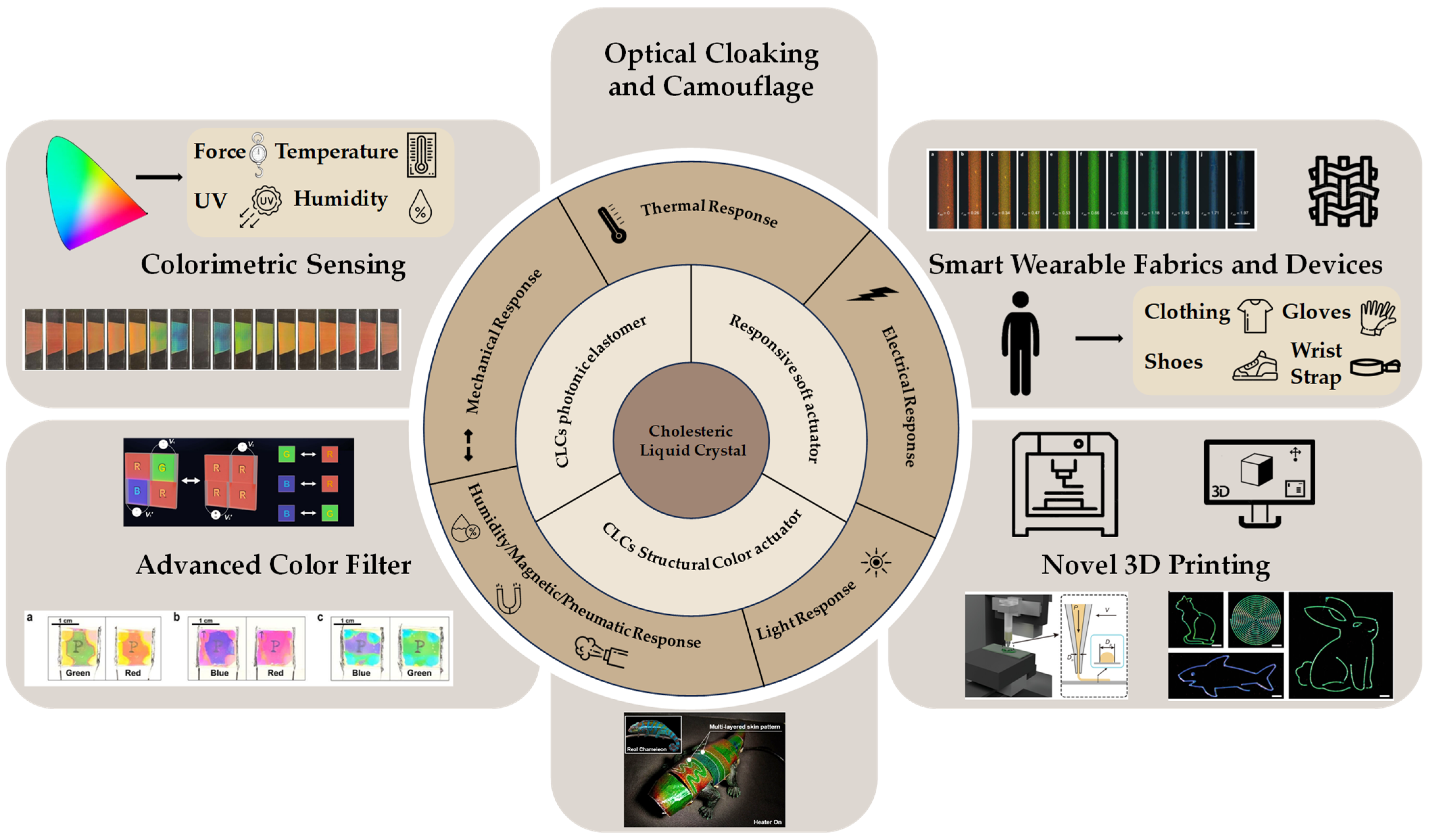







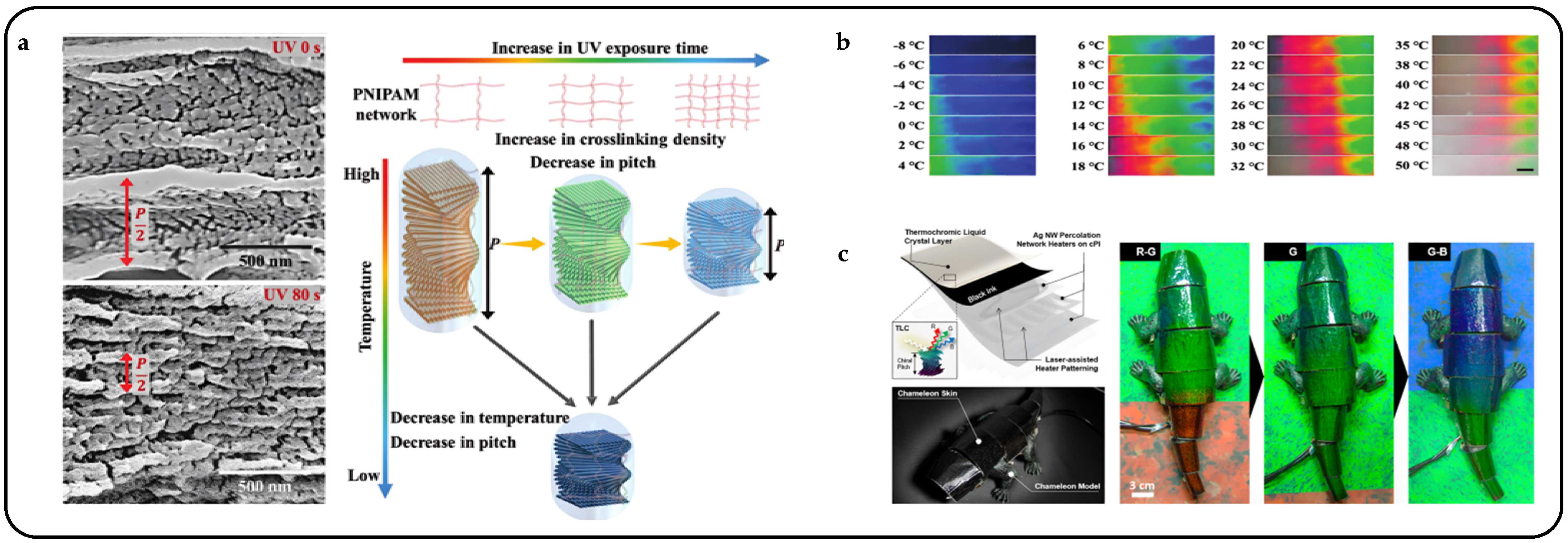
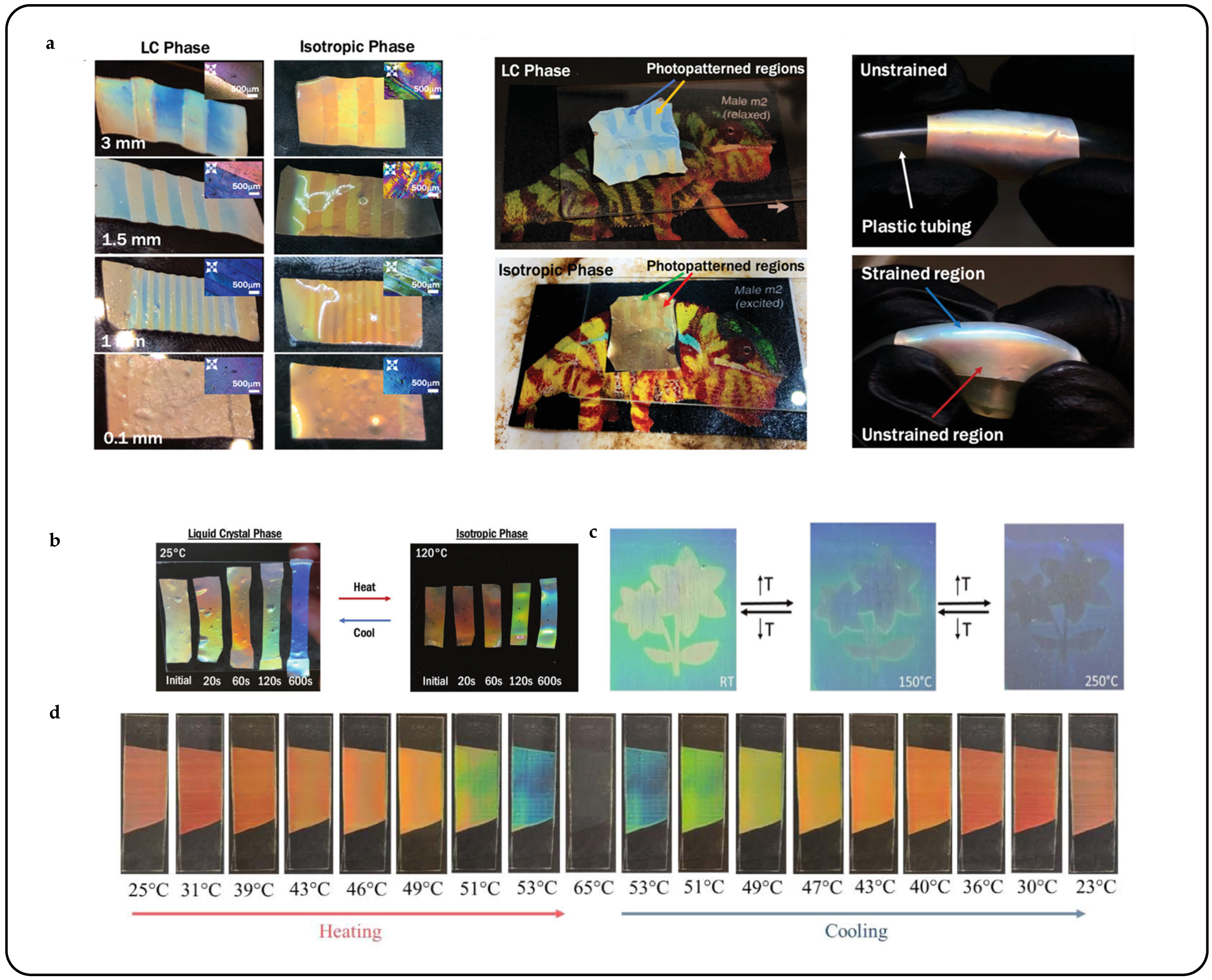
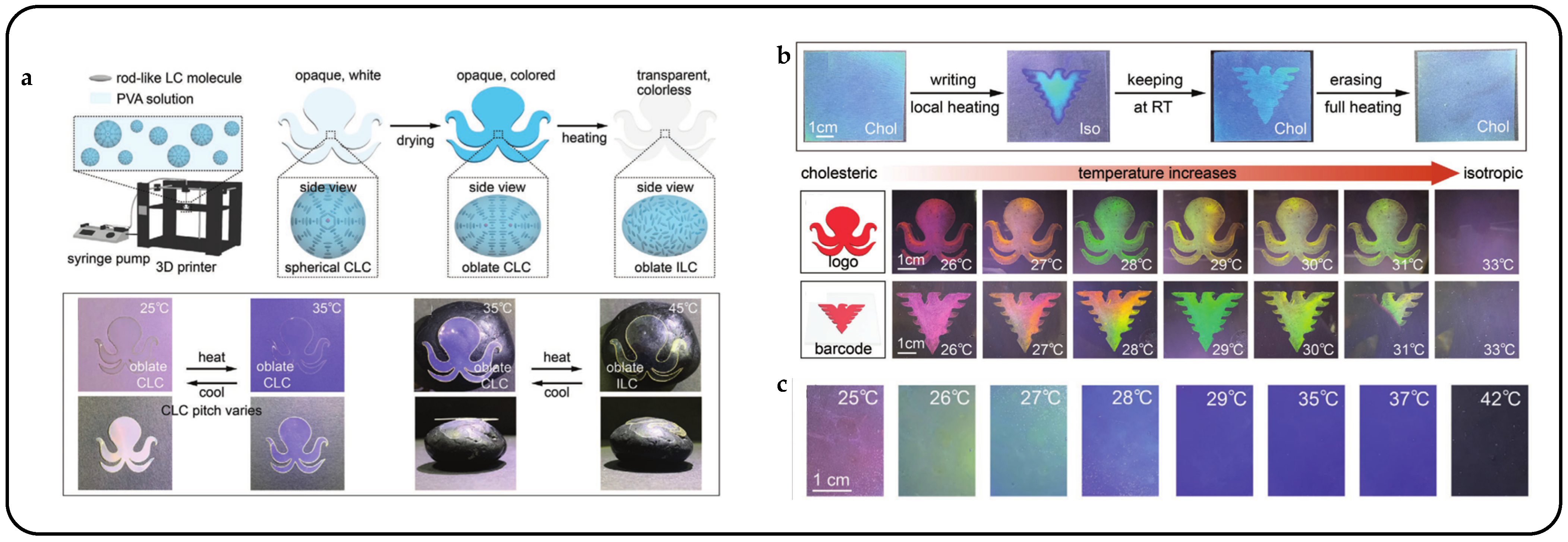



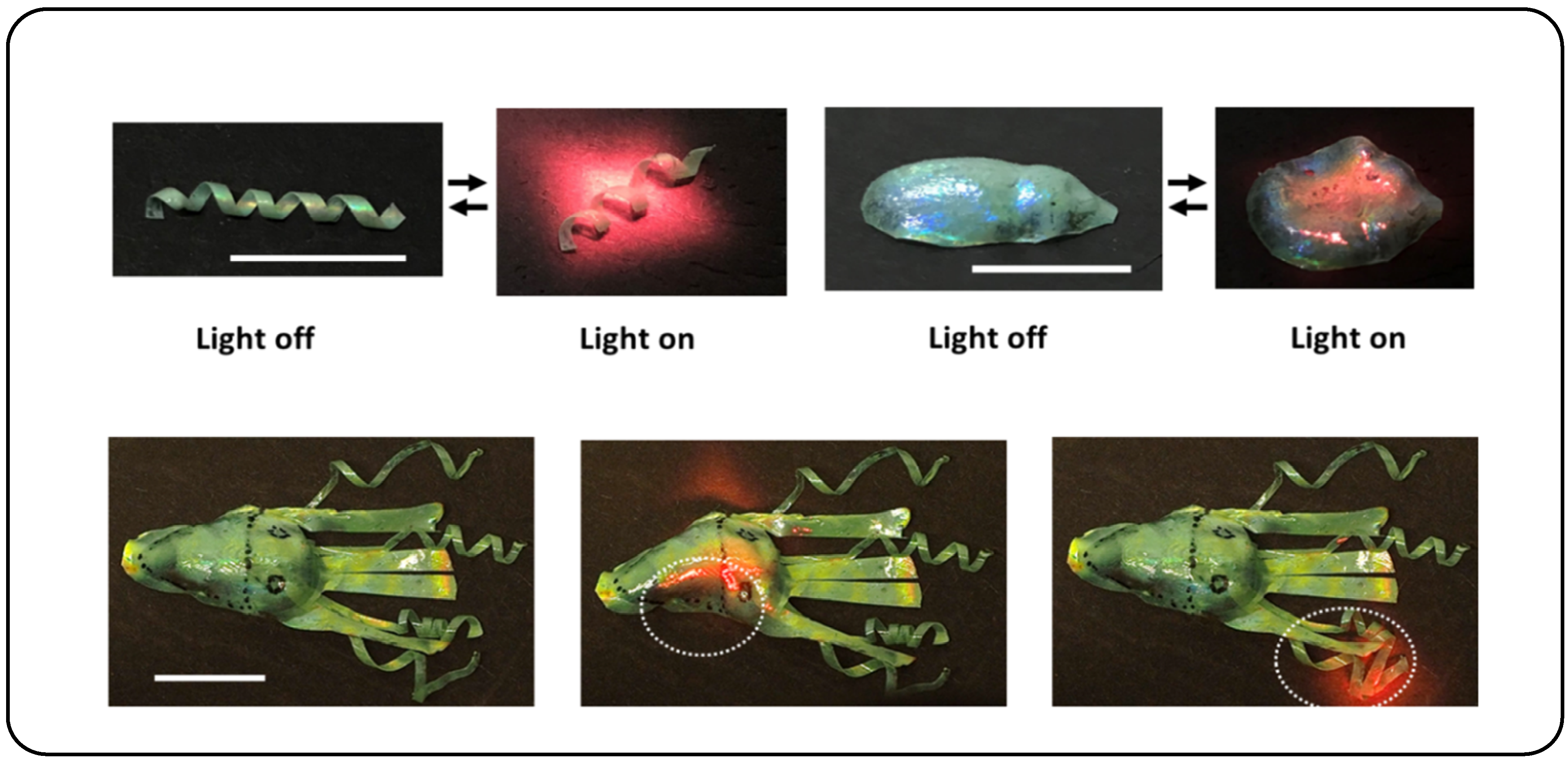
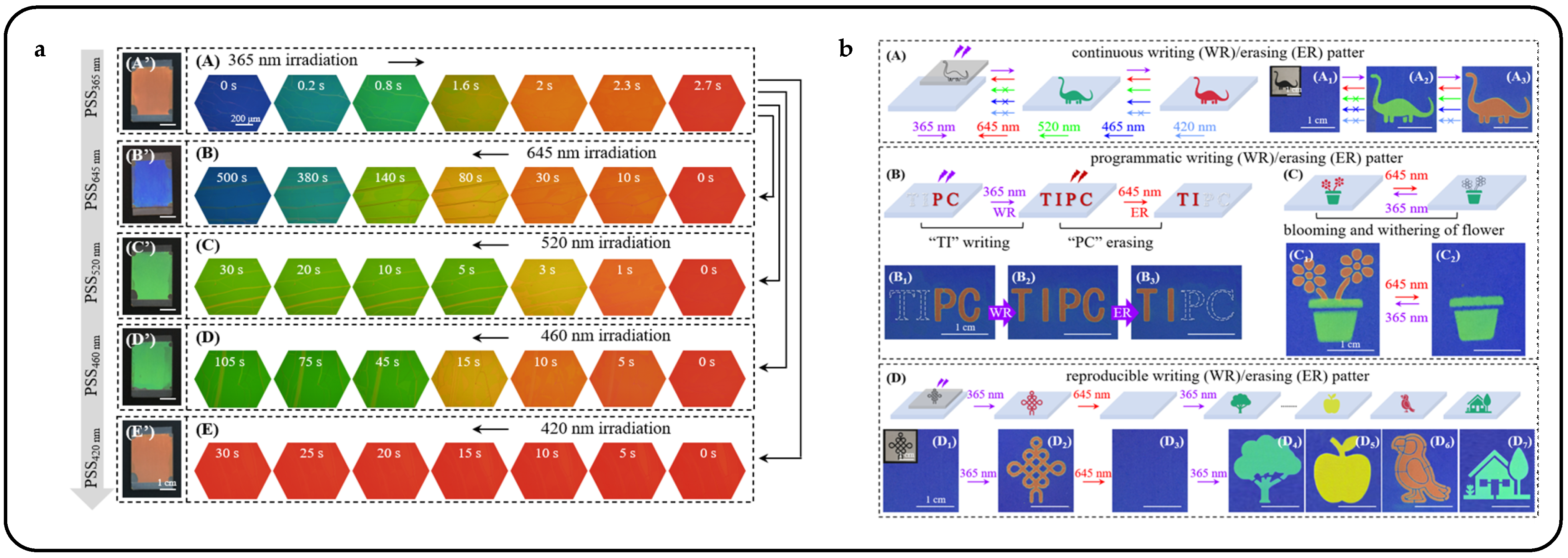
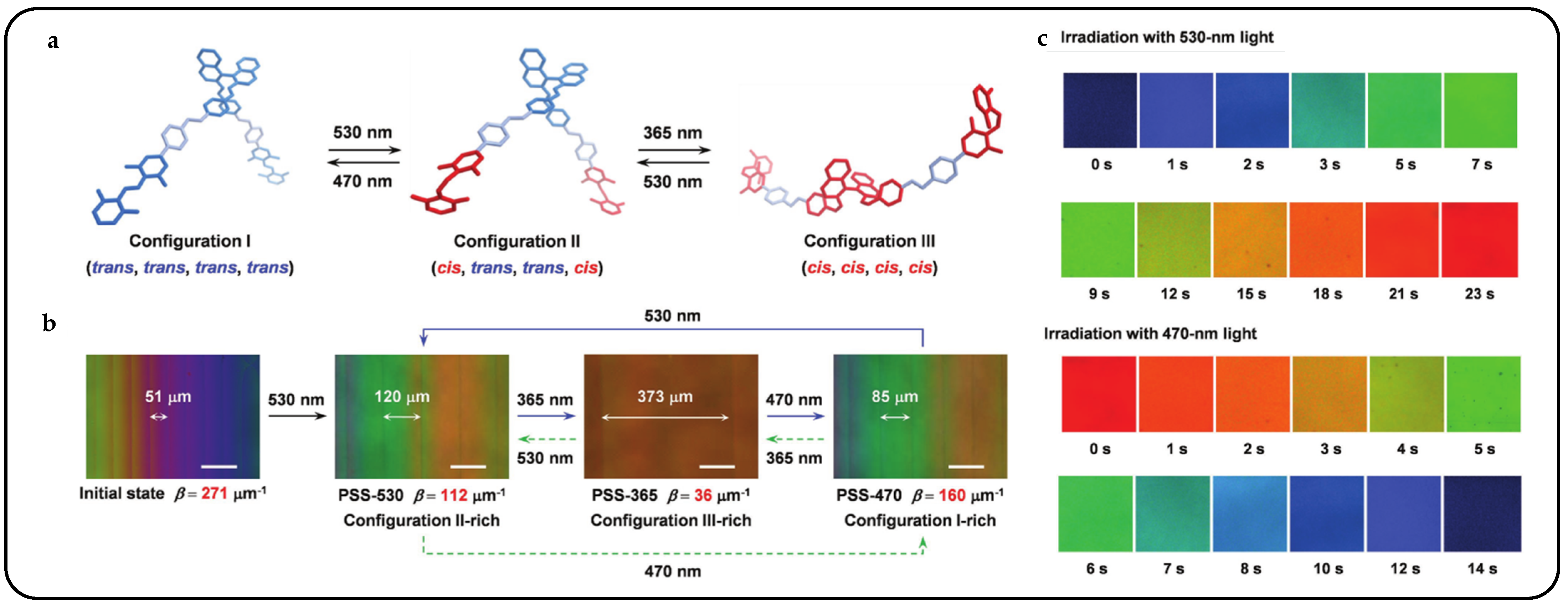

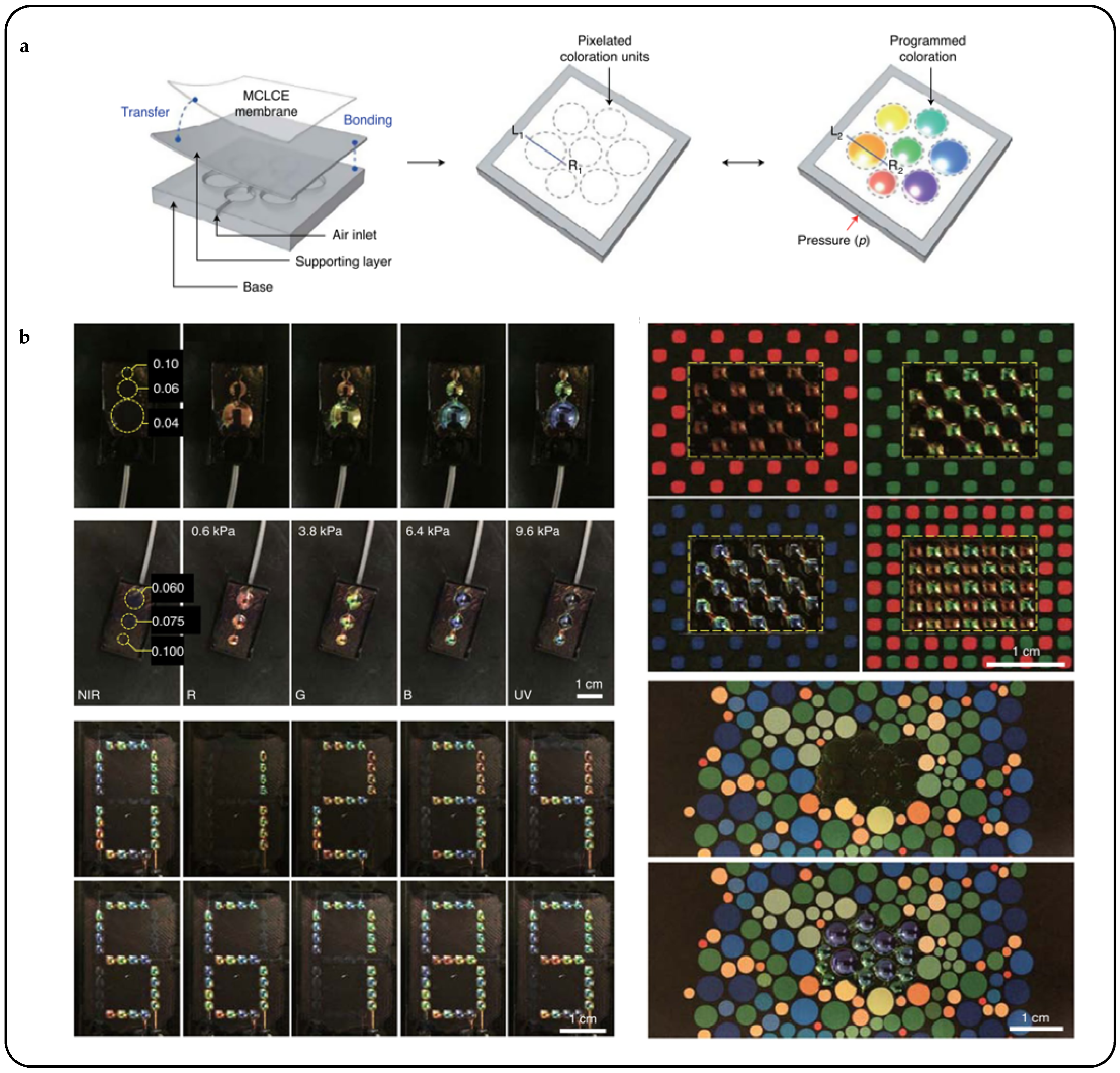
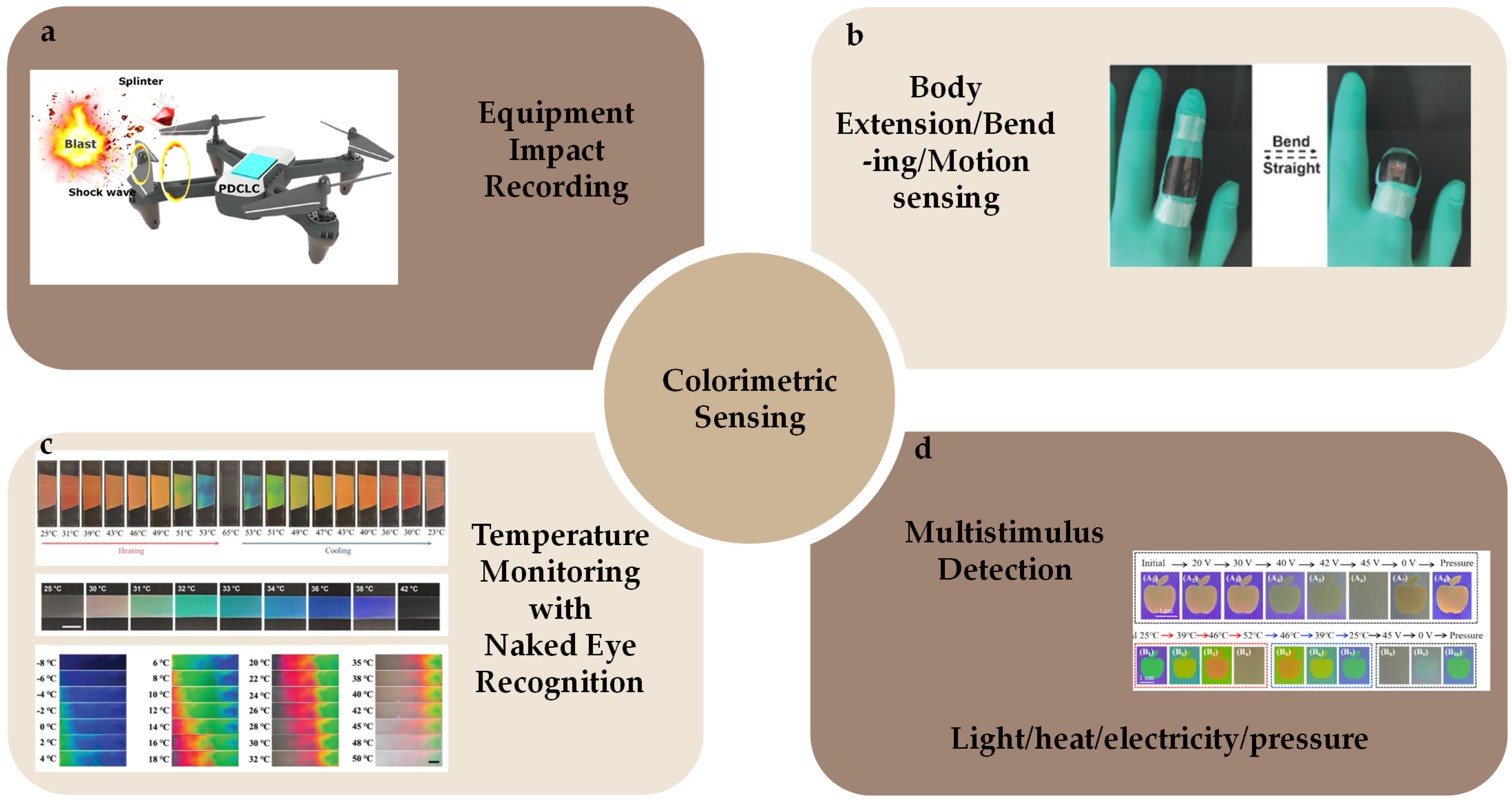
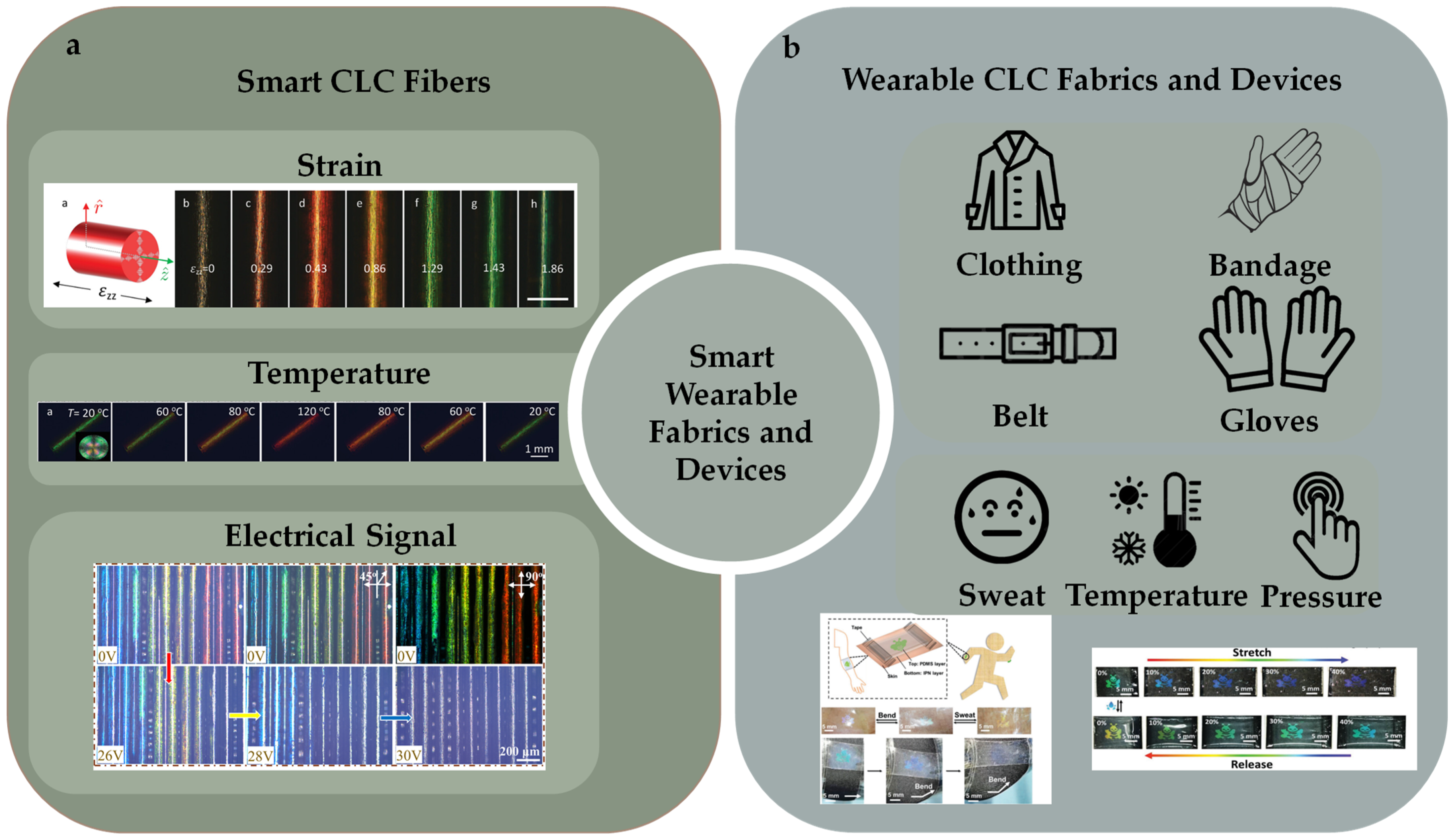
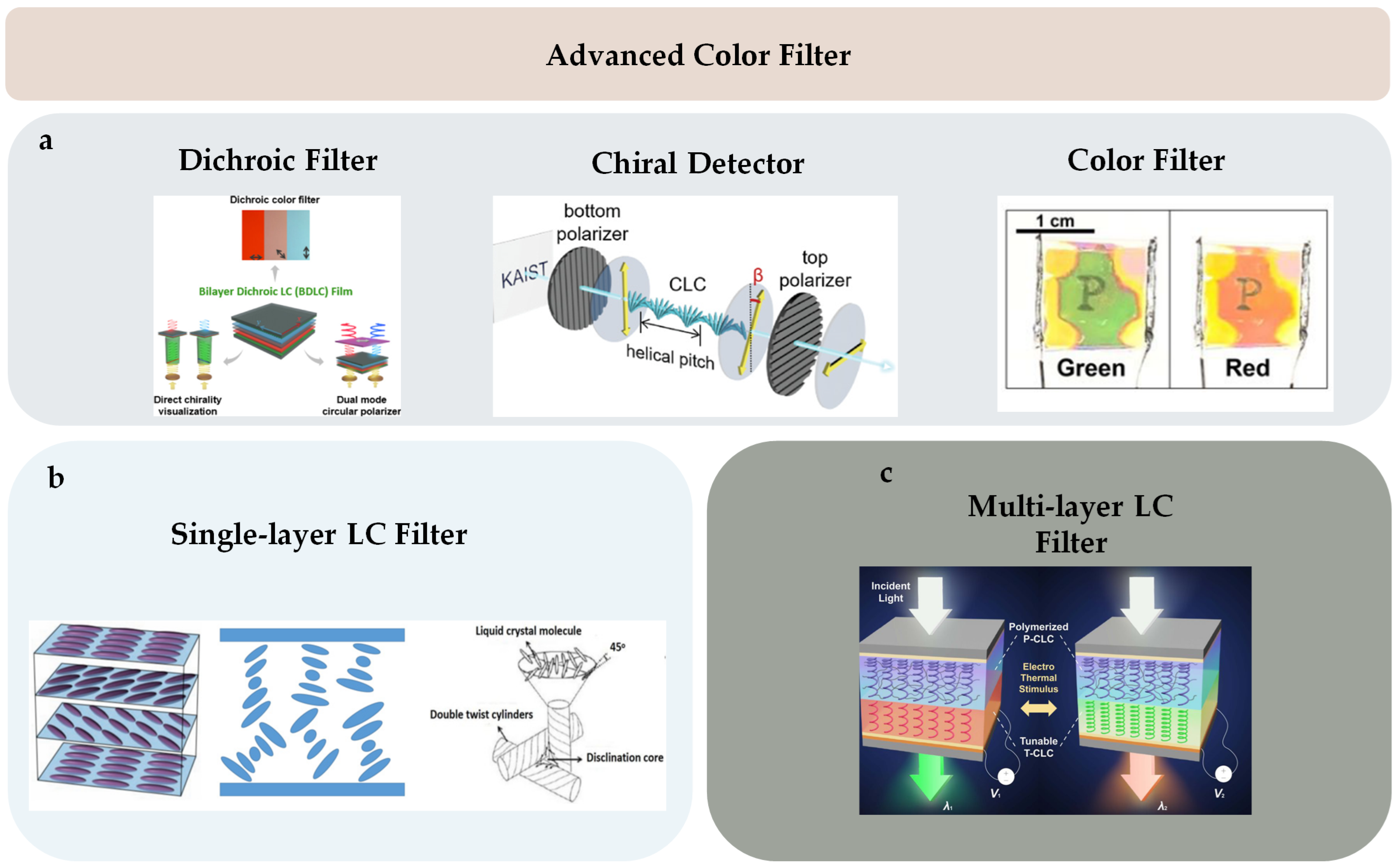

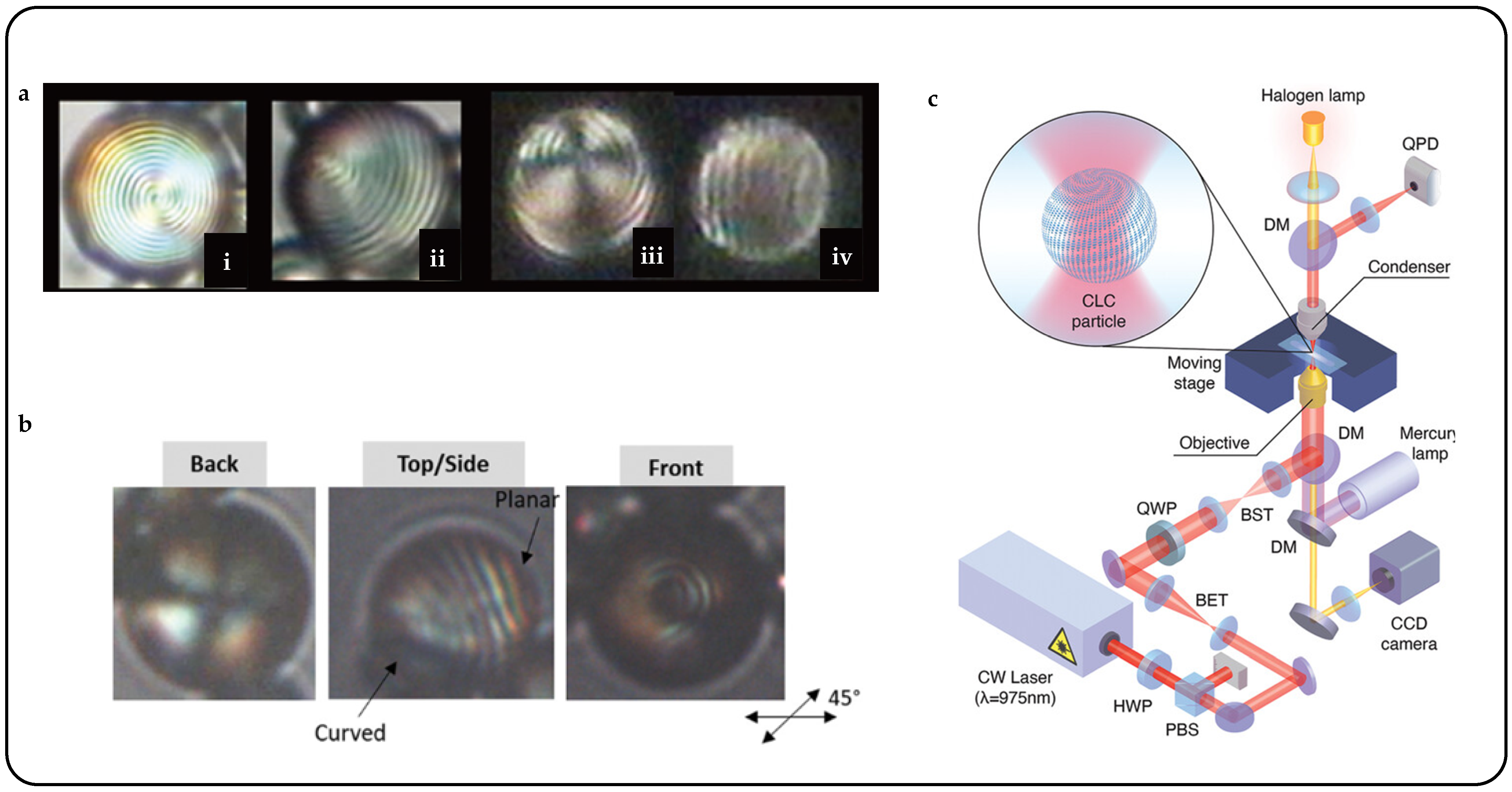
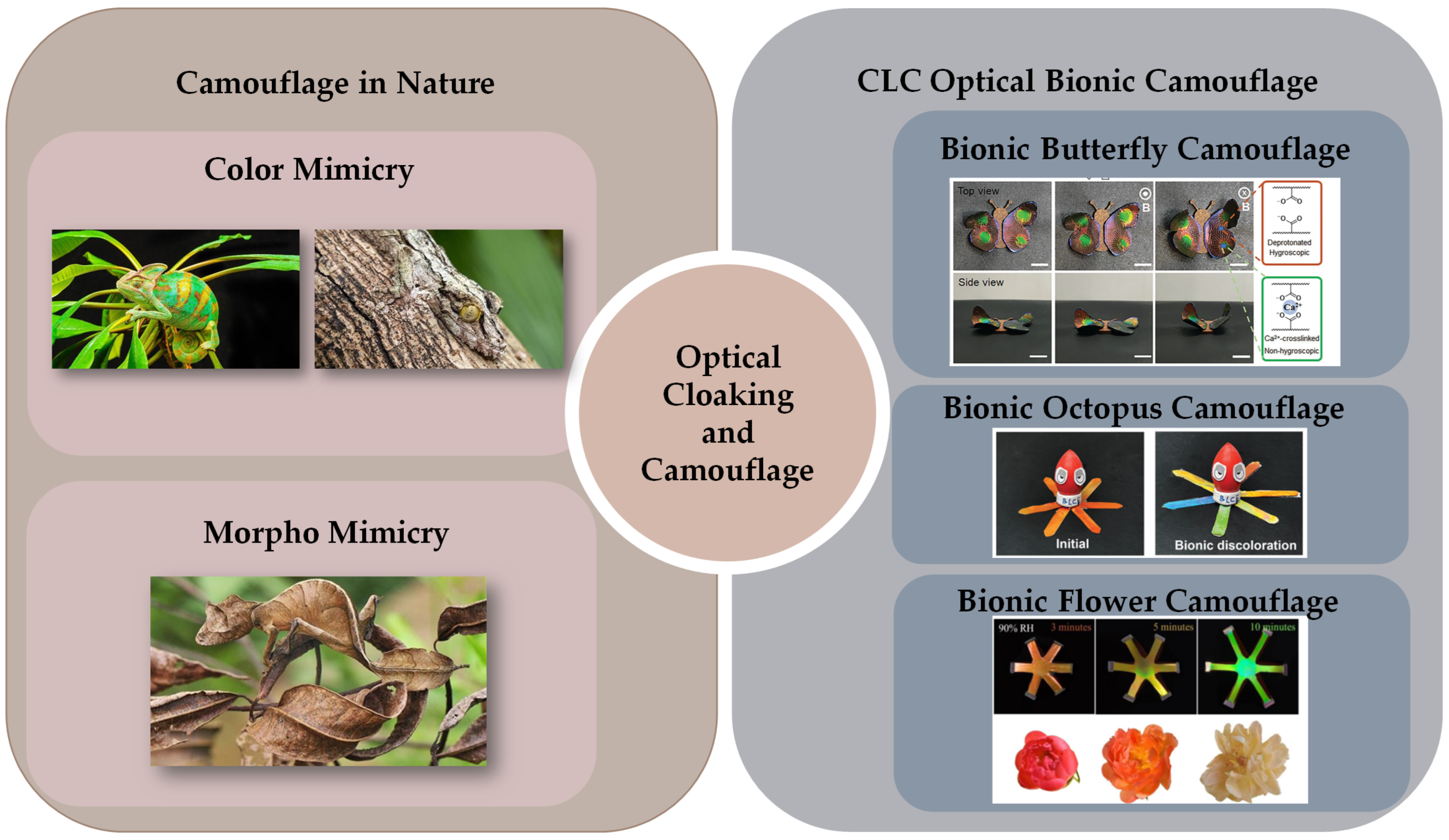
| Dynamic Covalent Bonding | Stimuli | Mechanism | Actuation | Ref. |
|---|---|---|---|---|
| Transesterification reactions | Heat | Exchange of ester and alcohol groups in the presence of acid/base catalysts at elevated temperatures | Reversible shape memory | [62,67,68] |
| Disulfide bond exchange | Heat/UV | Dissociation and reforming in specific environments | Reversible shape memory | [63,69,70] |
| B−O bond dynamic chemistry | Heat/water | Reversible B-O bonds with self-healing properties and crosslinkable units | Self-healing | [71,72,73] |
| Thiol-anhydride bond exchange | Light/heat | The ring-opening reaction of anhydrides with thiols | Programmable shape editing | [74,75] |
| Carbon radical exchange | Force | Under mechanical stimulation, selectively cleaves unstable bonds, exhibiting fluorescence | Force-induced luminescence | [76,77] |
| Material | Mechanism | Ref. |
|---|---|---|
| spiropyran | The C-O bond breaks and opens the ring, causing local molecular rotation | [156,157,158,159] |
| diarylethenes | Under UV excitation, the compound rotates to form a colored closed loop, which can undergo opposite changes under visible light irradiation. | [160,161,162] |
| azobenzene | The cis–trans isomerism formed by –N=N– | [163,164,165,166,167,168] |
| spirooxazine | Two orthogonal planes connected by a spiral carbon atom as the center rotates under ultraviolet light | [173,174] |
| naphthopyran | C-O bond breaks and opens the ring, extending the planar and conjugated structure | [175,176] |
| Material | Stimuli | Mechanism | Structural Color | Ref. |
|---|---|---|---|---|
| CLC/PEG | Humidity | Interpenetrating polymer network (IPN) | Green to red | [183] |
| CLC polymer film | Humidity/temperature | H-bonded supramolecular CLC resulting in swelling/deswelling | Red to green | [185] |
| BPLC | Alkaline solution | Manipulating the lattice parameters of the nanostructures | 459–653 nm | [186] |
| CLCN/magnetic composites | Humidity/magnetic | Hygroscopic carboxylate salt groups | Green to red | [39] |
| CLC/PDMS | Aerodynamic | Gas-pressure-controlled CLC deformation produces structural color | 680–460 nm | [192] |
Disclaimer/Publisher’s Note: The statements, opinions and data contained in all publications are solely those of the individual author(s) and contributor(s) and not of MDPI and/or the editor(s). MDPI and/or the editor(s) disclaim responsibility for any injury to people or property resulting from any ideas, methods, instructions or products referred to in the content. |
© 2024 by the authors. Licensee MDPI, Basel, Switzerland. This article is an open access article distributed under the terms and conditions of the Creative Commons Attribution (CC BY) license (https://creativecommons.org/licenses/by/4.0/).
Share and Cite
Zhang, J.; Zhang, Y.; Yang, J.; Wang, X. Beyond Color Boundaries: Pioneering Developments in Cholesteric Liquid Crystal Photonic Actuators. Micromachines 2024, 15, 808. https://doi.org/10.3390/mi15060808
Zhang J, Zhang Y, Yang J, Wang X. Beyond Color Boundaries: Pioneering Developments in Cholesteric Liquid Crystal Photonic Actuators. Micromachines. 2024; 15(6):808. https://doi.org/10.3390/mi15060808
Chicago/Turabian StyleZhang, Jinying, Yexiaotong Zhang, Jiaxing Yang, and Xinye Wang. 2024. "Beyond Color Boundaries: Pioneering Developments in Cholesteric Liquid Crystal Photonic Actuators" Micromachines 15, no. 6: 808. https://doi.org/10.3390/mi15060808
APA StyleZhang, J., Zhang, Y., Yang, J., & Wang, X. (2024). Beyond Color Boundaries: Pioneering Developments in Cholesteric Liquid Crystal Photonic Actuators. Micromachines, 15(6), 808. https://doi.org/10.3390/mi15060808







